Polar Bears and the Wildlife
of Svalbard
Photo Tour
June 2014
Trip Report
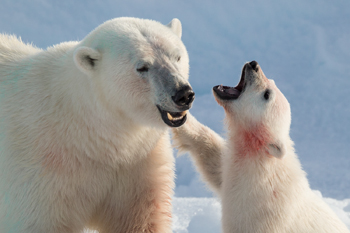
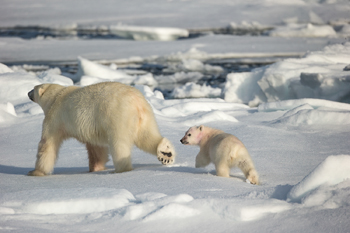
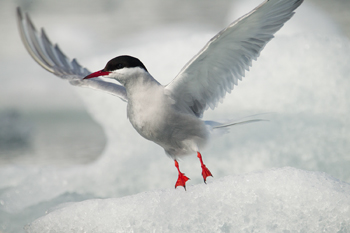

Polar Bear and cub;
Arctic Tern; Atlantic Walruses with a very young pup.
Mother and Cub; Bear on the fast ice near a glacier
.
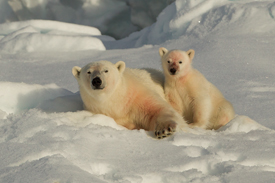
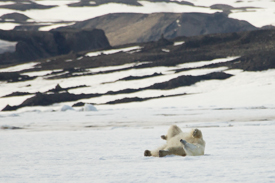
This trip was the third Mary and I have made to our northernmost destination, within 500 miles of the North Pole and far above the Arctic Circle. For those who know Polar Bears, the name Svalbard, or Spitsbergen as it was once called, is synonymous, as bears den, stalk the shorelines, and roam the pack ice and broken ice floes here, making this location a true Arctic experience.
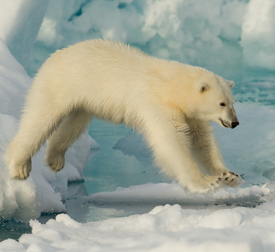 In truth, we thought it might be our last for a while, as the financial risk involved in making a huge deposit to secure what most everyone believe is the best ship to tour the archipelago is extreme. However, the lure of the Arctic and the wonderful shooting and natural history experiences were too much, and we secured our boat again for next year.
In truth, we thought it might be our last for a while, as the financial risk involved in making a huge deposit to secure what most everyone believe is the best ship to tour the archipelago is extreme. However, the lure of the Arctic and the wonderful shooting and natural history experiences were too much, and we secured our boat again for next year.
We sailed on a ship called the Stockholm, with a length of only 75 feet, limited to only 12 passengers, and, most importantly, with a deck that is so low that a bear, if we were moored 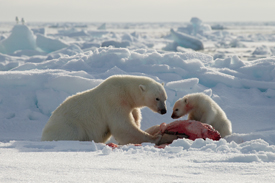 on ice, could touch or reach into the deck with its paw. Consequently, low level shooting is easy, and this year, with one of our bear encounters, we went one step better, photographing from open portholes that put us at eye-level with a bear as she and her cub fed upon a fresh Bearded Seal kill. It was an exquisite experience.
on ice, could touch or reach into the deck with its paw. Consequently, low level shooting is easy, and this year, with one of our bear encounters, we went one step better, photographing from open portholes that put us at eye-level with a bear as she and her cub fed upon a fresh Bearded Seal kill. It was an exquisite experience.
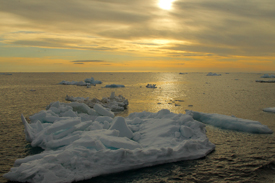 Traveling in early June, just weeks before the Summer Solstice and the longest day of the year, the sun never set and, on 'all-night' shoots with polar bears
the time can be almost disorienting, as after a full night of shooting, sleeping two hours before breakfast, and sleeping again until lunch, when another full day continued, it was as if we had had two days crammed into one. Our Expedition Leaders this year were superb, incredibly high-energy guys who, when we were in the ice or in bear country, would remain for hours in the Crow's Nest watching for bears, and how, indeed, the two best sightings were made.
Traveling in early June, just weeks before the Summer Solstice and the longest day of the year, the sun never set and, on 'all-night' shoots with polar bears
the time can be almost disorienting, as after a full night of shooting, sleeping two hours before breakfast, and sleeping again until lunch, when another full day continued, it was as if we had had two days crammed into one. Our Expedition Leaders this year were superb, incredibly high-energy guys who, when we were in the ice or in bear country, would remain for hours in the Crow's Nest watching for bears, and how, indeed, the two best sightings were made.
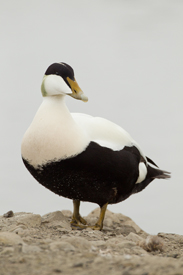 This trip always offers more than just bears, and I think we're the only tour that rents vehicles (until our competitors read this, of course) for drives into the countryside where we photograph Eider Duck, Rock Ptarmigan, Reindeer, and any other species we encounter. On my 'scouting trip' here a few years ago we had to walk to where ever we were going, a major inconvenience and hassle when you are carrying big lenses, or hoping to see all that Svalbard has to offer. By renting vehicles, we could do just that!
This trip always offers more than just bears, and I think we're the only tour that rents vehicles (until our competitors read this, of course) for drives into the countryside where we photograph Eider Duck, Rock Ptarmigan, Reindeer, and any other species we encounter. On my 'scouting trip' here a few years ago we had to walk to where ever we were going, a major inconvenience and hassle when you are carrying big lenses, or hoping to see all that Svalbard has to offer. By renting vehicles, we could do just that!
On last year's trip, northern winds pushed the pack ice south, and almost cut off our route to return to port. This year, as we've found almost everywhere in the world we've visited, the spring was cold, and this applied to Svalbard as well. When we arrived, the northernmost portion of the archipelago, and the route we normally travel, was closed, blocked by the arctic ice pack. Our only option was to travel south, then east-northeast to reach exciting new country, and to hit the pack ice that still lingered near one of the major bear denning areas in Svalbard. Although that area is off-limits, the ice that surrounded the islands and extended far out to sea had bears, and here we had our most incredible encounters.
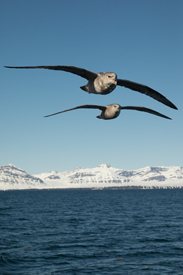 But as always, the trip offered more than just bears, with incredible scenics, great Atlantic Walruses, Bearded and Ringed Seals, Northern Fulmars, and many other birds all being a part of the shooting experience.
But as always, the trip offered more than just bears, with incredible scenics, great Atlantic Walruses, Bearded and Ringed Seals, Northern Fulmars, and many other birds all being a part of the shooting experience.
Our traveling north went smoothly, and no one was hassled at the airports about our gear. Mary and I carried our equipment in Gura Gear Bataflae bags, as did several others, while some, with lighter gear, used the Kiboko bags. In addition to using the Bataflae bags for our air travel, we also used the bags when we would land. Mary's could keep a camera mounted on her 500mm (with the hood reversed) inside the bag, while my longer 800mm fit inside, with the hood reversed, but I had to mount the camera on once I got ashore. Mary and I used our Really Right Stuff tripods, and Wimberley Model II gimbal heads, which worked quite effectively on the deck of the ship. In the zodiacs we hand-held our gear, Mary often using a 28-300mm and I used a 70-300mm for the wildlife shots. Because I now own an 800mm I used it, but most folks used 500mm, or 200-400mms, or 100-400mms, for the shooting. As usual, I was shooting with Hoodman CF cards, and normally I'm using the latest card, a 64 gb speed demon. However, on one occasion I had another, older version mounted instead, and I was wondering why I was occasionally buffering out as I shot 12fps bursts. That normally doesn't happen, and I was puzzled, so I opened the camera and saw the older card. I quickly changed, and the new CF cards are blazingly fast and I never buffered out. I loved the old Hoodmans, but the new ones, a UMDA 7, 1000X, are simply incredible.
I'm getting a head of myself here, as some of this will be repeated in the trip report, that follows, below!
Day 1. Longyearbyen
We arrived in Longyearbyen on time, with everyone arriving in Oslo at least one day before this morning flight. We learned, after last year, when we flew SAS and still nearly missed the flight, with the slow processing of tourists at the airport. Arriving in plenty of time, this year, we had no trouble, especially since, with my back, I asked if I could board early, was okayed, and nearly everyone in our group simply followed me on! That was fortunate, as the flight was full and overhead space became precious.
After checking in to our hotel (the Svalbard Hotel), we had a mid-afternoon lunch in preparation for a drive into the countryside to look for birds and wildlife. On the gangplank-like steps of the nearby restaurant Dave slipped, and so severely jammed his foot that he thought he had broken it, although he didn’t say anything at the time.
Although the skies were overcast and the light was decent, and we drove out the mile to the dog kennels where, under the barking protection of sledge dogs to keep Arctic fox at bay, dozens of Common Eiders nest. We photographed birds posing, swimming, and, tossing their heads back in a quick grunt, calling.  A Parasitic Jaeger flew over frequently, circling the nesting colony as this northern skua looked for vulnerable eggs or the first chicks of the year. It was unsuccessful, but the bird did give us a few fleeting opportunities for shots. Barnacle Geese not only spotted the tidal flats below the colony but were also, this year, mixed within, giving us the best opportunities we’ve had for close-ups of this white-faced, Brant-like goose.
A Parasitic Jaeger flew over frequently, circling the nesting colony as this northern skua looked for vulnerable eggs or the first chicks of the year. It was unsuccessful, but the bird did give us a few fleeting opportunities for shots. Barnacle Geese not only spotted the tidal flats below the colony but were also, this year, mixed within, giving us the best opportunities we’ve had for close-ups of this white-faced, Brant-like goose.
We continued out of town, looking for, and soon finding, Reindeer. One fairly good buck, its antlers still in velvet, was fairly close to the road and cooperated well. A great example of Allen’s (or Bergman’s?) rule, where in northern climates limbs and extremities shorten to conserve heat, the reindeer’s legs are very short, giving the animal a stout, barrel-like appearance.
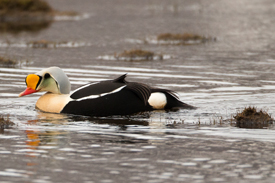
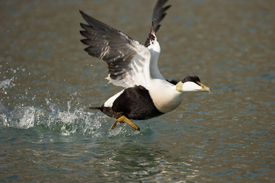
King Eider, left; Common Eider, right.
Heading back towards town I spotted a pair of King Eiders who swam fairly close to shore, and continued swimming parallel to us until they found a gap in the bay where they could head away. Several Purple Sandpipers plumbed the shoreline mud, close enough that we could read their color-coded bands, 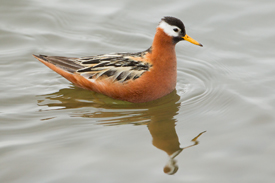 and two Red Phalaropes, the females brightly colored in red and white markings, swam nearby along the shoreline. Phalaropes are one of the few birds where the females are polyandrous, mating with several males, who are stuck with incubating the eggs and caring for the precious young. Like all shorebirds, the chicks are well-developed upon hatching, and are immediately mobile and able to feed themselves, although they mimic and observe their sole parent, the male.
and two Red Phalaropes, the females brightly colored in red and white markings, swam nearby along the shoreline. Phalaropes are one of the few birds where the females are polyandrous, mating with several males, who are stuck with incubating the eggs and caring for the precious young. Like all shorebirds, the chicks are well-developed upon hatching, and are immediately mobile and able to feed themselves, although they mimic and observe their sole parent, the male.
Our last target species for the day was the extremely well-camouflaged 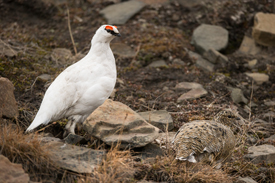 Rock Ptarmigan, a high country grouse that, like all members of the Ptarmigan family, turn white in winter and brown, or gray in the case of the Rock, in summer. Jack spotted a female near the road and soon we found another, and a nearly pure white male that flew down the mountain slope to join Jack’s female. As he landed in the snow he flared his black outer tail feathers in display, but soon folded those feathers, revealing only his vivid, erect comb of red flesh above his eyes. The birds were incredibly tame and although it appeared as if they were about to mate the female always scurried away and, chastened, the male’s red display crest slowly receded.
Rock Ptarmigan, a high country grouse that, like all members of the Ptarmigan family, turn white in winter and brown, or gray in the case of the Rock, in summer. Jack spotted a female near the road and soon we found another, and a nearly pure white male that flew down the mountain slope to join Jack’s female. As he landed in the snow he flared his black outer tail feathers in display, but soon folded those feathers, revealing only his vivid, erect comb of red flesh above his eyes. The birds were incredibly tame and although it appeared as if they were about to mate the female always scurried away and, chastened, the male’s red display crest slowly receded.
We returned to our hotel where we discovered Dave was hurting far more than he let on, and Mary and I took him to the town’s hospital where a doctor had to be called in, since it was after 4. Dave’s foot wasn’t broken, just badly stressed, but the doctor did provide some entertainment as he displayed little humor, a very Prussian attitude, and a sense of shock when, one, Mary wrote Dave’s birth date the US way, with the month first, and two, when he discovered none of us had a cell phone! His silent stare as he looked at us, silently, for each of these transgressions was priceless.
Day 2. Although the sun never sets, our ‘morning’ dawned clear, with an almost cloudless sky, and we repeated the agenda from yesterday, shooting the Eider ducks, Reindeer, and Ptarmigan again. After lunch we visited the 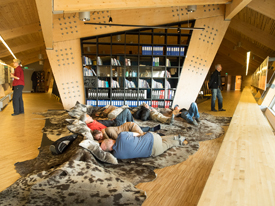 museum where most of us fell asleep on the seal rugs laid out in the reading area, the bunch of us resembling a group of hauled-out walruses on a beach. (Photo, Tom Wester)
museum where most of us fell asleep on the seal rugs laid out in the reading area, the bunch of us resembling a group of hauled-out walruses on a beach. (Photo, Tom Wester)
At 3:30 we walked to the boat dock where we met the guides and crew, and by 6 left port for our journey south.
Last year, as we had the year before as well, we had traveled north, but the ice this year covered the northern portions of the island, making our usual stops impossible. The boats previous trip had been to the south as well, and they did quite well, and we were excited as this would be new country for us, and would go to the ice pack where bears are common. Our sea travel that night went uneventfully, with extremely calm seas.
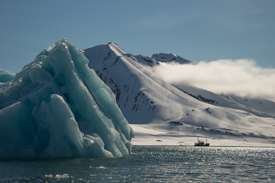
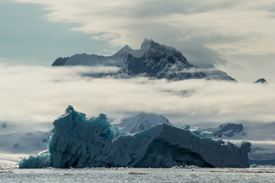
Day 3. We dropped anchor before breakfast at one of the southernmost fjords on the main island, at Burgebudte, where several glaciers meet the sea in a three branched fjord. At 9:30 we did a zodiac cruise, hoping to encounter polar bears, as a few spend the year here and we saw their tracks several times. Old tracks were unique, as they were actual casts, as the bear’s weight compressed the snow such that as the surrounding snow, uncompressed, melted, the more solid snow from the tracks remained, creating weird, raised steps, like a series of cement blocks, traipsing across the snow fields. Fresh tracks were, as expected, indented into the snow, but none led to a bear.
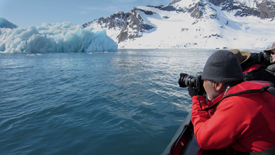 (Jack with the glacier, Adam Rheborg photo)
(Jack with the glacier, Adam Rheborg photo)
At the face of one of the glaciers, from nearly 300 yards away, we motored about in the zodiacs as the glacier began to calve, at first dropping snow blocks (perhaps the size of cars) into the sea with rifle-crack blasts. One ridge had constant action, with little landslides suddenly popping into view, preceded by the loud blasts of breaking ice. Eventually, as we had hoped, the entire wall crumbled, sliding into the sea, and followed by a chain reaction as more and more ice broke off from the glacial face and crashed into the frigid waters.
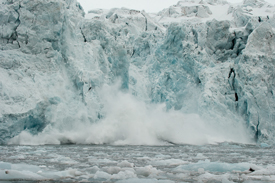

Photo on right by Bill Sailer
A tsumami formed, and our guide turned the zodiac to speed off, fearing that the huge wave might crest if the pulse of water passed over a shallow reef. Fortunately it did not, but we rode huge swells as the wave passed under us. It was, without a doubt, the best calving we’d ever seen, and certainly never as close.
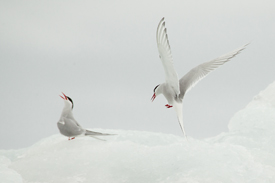
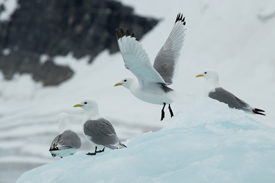
Arctic Terns; Black-legged Kittiwakes
Although we saw only one Harbor Seal, we had extremely good luck with a rare species of gull, the Ivory Gull, a species associated only with the ice and famous for living off the scraps of bear kills. Our bird, black legged with a a gray-black bill, was extremely cooperative and only took flight when two Black-legged Kittiwakes (a small gull species) flew in to join the gull, then took off, taking our Ivory gull with them. We also photographed several groups of cooperative Northern Fulmars as they perched on ice floes, framed by the glacial face behind.
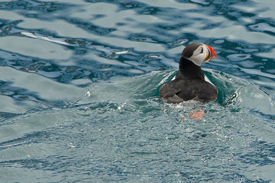
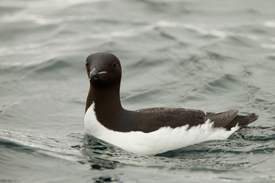
Atlantic Puffin; Thick-billed Murre
After lunch we continued exploring the fjords, hoping to find a bear but without success, although we did photograph more Fulmars, a few Common Puffins, and spectacular landscapes. At 5 most of us were down-loading when one of the A-Bs, Able-bodied Seamen, ran down to tell us a Humpback 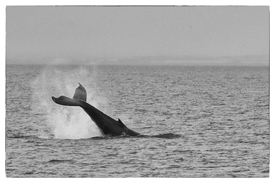 Whale was spotted. We spent the next hour with the whale, who began with some unexpected tail-slapping, but later only did some nice, and very close, soundings, where its distinctive tail pattern was visible.(photo, Judy Johnson)
Whale was spotted. We spent the next hour with the whale, who began with some unexpected tail-slapping, but later only did some nice, and very close, soundings, where its distinctive tail pattern was visible.(photo, Judy Johnson)
By 6:30 we were heading south, soon to reach the southernmost tip of Svalbard before heading across the open seas to reach the eastern island of the archipelago, new land for all of us.
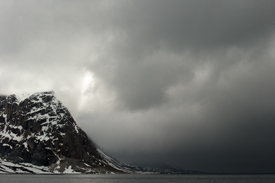 Day 4. Our unexpected visit with the Humpback whale potentially cost us time to the East, so we planned a brunch at 9:30 with an expected landfall at Bjombuka, for Atlantic Walruses, around noon. Fortunately, during the night a strong westerly wind propelled our ship forward against the current, gaining us the hour we had lost yesterday with the whale. Accordingly, we had an earlier breakfast, and a landfall, via zodiac, by 9:30AM.
Day 4. Our unexpected visit with the Humpback whale potentially cost us time to the East, so we planned a brunch at 9:30 with an expected landfall at Bjombuka, for Atlantic Walruses, around noon. Fortunately, during the night a strong westerly wind propelled our ship forward against the current, gaining us the hour we had lost yesterday with the whale. Accordingly, we had an earlier breakfast, and a landfall, via zodiac, by 9:30AM.
 The walrus haul out was quite large, extending about two hundred yards along the beach, divided into two pods, with one mostly males and the other a mixture of males and a few females with calves. The calves were born less than a month ago, at around 80 kg, and although still quite young they looked much like the adults, except for a lack of tusks. Babies remain with their mothers for up to 2.5 years, in contrast to most seals (of either family or major division) where the babies are nursed or cared for for a few weeks at most. In fact, the Hooded Seal, one of the largest species, has the record for any mammal, weaning the baby in just four days.
The walrus haul out was quite large, extending about two hundred yards along the beach, divided into two pods, with one mostly males and the other a mixture of males and a few females with calves. The calves were born less than a month ago, at around 80 kg, and although still quite young they looked much like the adults, except for a lack of tusks. Babies remain with their mothers for up to 2.5 years, in contrast to most seals (of either family or major division) where the babies are nursed or cared for for a few weeks at most. In fact, the Hooded Seal, one of the largest species, has the record for any mammal, weaning the baby in just four days.
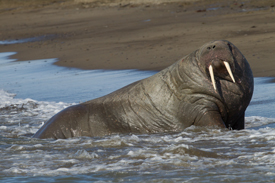
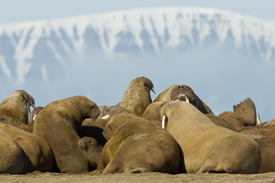
On the last trip to this haul out, Adam, our guide, watched as four Reindeer swam across the bay from a nearby island towards this beach. One hundred yards out a walrus suddenly rose and stabbed the reindeer, probably mistaking it for a polar bear. It killed it instantly, leaving a hatchet-like divot in the ribcage, where one of the lungs floated free. We didn’t see any violence today, although at the end of the visit, while we motored about in a zodiac watching some young males play-fighting, a torpedo-like wake sped towards us, a charging walrus swimming beneath the waves. Adam jumped to the front with a paddle, intending to bump its nose should it make contact, but the walrus lost its nerve at the last moment and swerved, thrashing the water in big splashes as it did so.
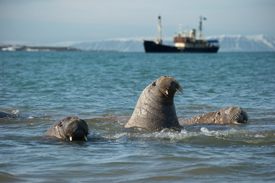 I was surprised at how uncaring the walruses were to our presence. At previous haul-outs, perhaps because they are more frequently visited and thus disturbed, walruses often ambled, or rushed, towards the sea. These did not, although perhaps the difference was that Adam spoke loudly, letting the walruses know we were present. Memory fails me here, but I believe that we moved in rather quietly on other trips, and perhaps suddenly surprised the walruses with our unexpected appearance when they awoke. At any rate, none of the walruses showed any sign of disturbance, and we circled about, fortunately getting upwind and on the sunny side of the groups. En route, the smell was quite strong, and one can truly say that a group of walruses really do stink!
I was surprised at how uncaring the walruses were to our presence. At previous haul-outs, perhaps because they are more frequently visited and thus disturbed, walruses often ambled, or rushed, towards the sea. These did not, although perhaps the difference was that Adam spoke loudly, letting the walruses know we were present. Memory fails me here, but I believe that we moved in rather quietly on other trips, and perhaps suddenly surprised the walruses with our unexpected appearance when they awoke. At any rate, none of the walruses showed any sign of disturbance, and we circled about, fortunately getting upwind and on the sunny side of the groups. En route, the smell was quite strong, and one can truly say that a group of walruses really do stink!
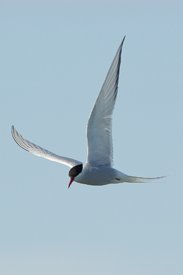 The beach was littered with the disintegrating vertebrae and partial skulls of walruses slaughtered not that long ago … in 1952, the year I was born, walruses in Svalbard were finally protected. In 2007 a census counted approximately 3,000 walruses, although at the time of protection finding ANY on the islands was a rarity. Today, there may be nearly twice that number, and Adam hopes that one day they’ll litter the beach en masse, as they probably did before Europeans wiped them out for oil, ivory, and eventually hides, used in making industrial belts for machinery.
The beach was littered with the disintegrating vertebrae and partial skulls of walruses slaughtered not that long ago … in 1952, the year I was born, walruses in Svalbard were finally protected. In 2007 a census counted approximately 3,000 walruses, although at the time of protection finding ANY on the islands was a rarity. Today, there may be nearly twice that number, and Adam hopes that one day they’ll litter the beach en masse, as they probably did before Europeans wiped them out for oil, ivory, and eventually hides, used in making industrial belts for machinery.
We had several swim close to the beach to investigate, and in the distance young males fought in the surf. Twice Arctic Terns flew close by and dove for  fish, and a pair of Oldsquaws, not politically correctly called Long-tailed Ducks, occupied a small pond along the beach. After two hours or so we headed back to our ship, continuing to the Northeast and on to polar bear country.
fish, and a pair of Oldsquaws, not politically correctly called Long-tailed Ducks, occupied a small pond along the beach. After two hours or so we headed back to our ship, continuing to the Northeast and on to polar bear country.
(Photo, Don Lewis)
Day 5. Hoping for the best, Mary and I stayed up late, fruitlessly wasting time watching for bears in what was, essentially, an open sea, as ice floes were small and scattered. By mid-night we had gone to bed, only to be awakened at 1:30AM by Adam, who had spent the last three hours in the crow’s nest watching for bears. He’d spotted one, far in the distance, lying atop a snow pile on a fairly substantial  ice floe, twisted and blocky as a pressure ridge. Everyone was soon on deck as we slowly, and cautiously, approached the bear. At first the bear did nothing, lifting its head occasionally to watch our approach, but as we neared it became more animated, and when we were in great shooting distance the bear grew curious, circling about on the floe as it investigated these new scents and, it seemed, toying with the idea of actually approaching the ship. As it was, the bear was a frame-filling subject with 300mm, and the 2AM light was soft and golden, with a bear
ice floe, twisted and blocky as a pressure ridge. Everyone was soon on deck as we slowly, and cautiously, approached the bear. At first the bear did nothing, lifting its head occasionally to watch our approach, but as we neared it became more animated, and when we were in great shooting distance the bear grew curious, circling about on the floe as it investigated these new scents and, it seemed, toying with the idea of actually approaching the ship. As it was, the bear was a frame-filling subject with 300mm, and the 2AM light was soft and golden, with a bear
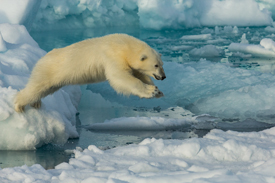
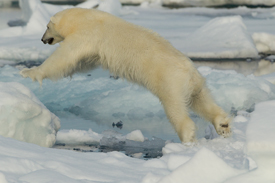
Bear on left by Bill Sailer
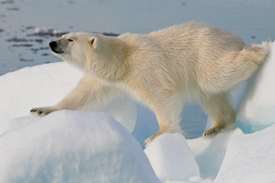
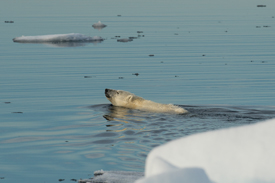
Left, by Jack Fumaura; Right, by Judy Johnson
glowing a pristine, sparkling white. Twice the bear jumped from one floe or ridge to another, and I missed them both, although several, including Mary, got some great shots.
 After 1.5 hours the bear finally moved off, unhurriedly walking away from us and entering the water without a splash. The bear swam to the north, at a speed approaching two knots, and since the protocol is to not approach a swimming bear, for fear of stressing it, we left it to continue on ourselves. We returned to our cabins, intending to get some sleep when David, our other guide, who had relieved Adam in the Crow’s Nest, spotted another bear. We headed back on deck.
After 1.5 hours the bear finally moved off, unhurriedly walking away from us and entering the water without a splash. The bear swam to the north, at a speed approaching two knots, and since the protocol is to not approach a swimming bear, for fear of stressing it, we left it to continue on ourselves. We returned to our cabins, intending to get some sleep when David, our other guide, who had relieved Adam in the Crow’s Nest, spotted another bear. We headed back on deck.
Photo, left by Adam Rheborg
Adam approached, and told me we may have struck gold – a mother bear with two cubs and a kill! As we grew closer, the female would raise her head above the pressure ridge for a brief moment, checking us out, and a cub would periodically appear, often climbing atop the snow ridge for a full view. We inched closer, eventually clearing the obstructing snow ridge and having a clear view of the 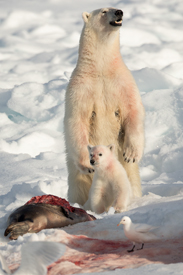 bears (a mother and one cub) and their kill, a Bearded Seal, still steaming in the cold air. Our Expedition Leaders suspected the kill was less than an hour old, and maybe fresher, and we suspect that the male bear we’d been photographing had smelled the kill and had swam off in that direction.
bears (a mother and one cub) and their kill, a Bearded Seal, still steaming in the cold air. Our Expedition Leaders suspected the kill was less than an hour old, and maybe fresher, and we suspect that the male bear we’d been photographing had smelled the kill and had swam off in that direction.
We stayed with the mother bear for about 2.5 hours, and our captain, and the First Mate once the captain took his break, did an incredible job, maneuvering the ship to provide us with several angles. At first I thought the bear might be nervous and was about to desert the kill, as she walked a short distance away from the seal, with her six month old cub bawling its complaints as she did so. With the carcass now abandoned, Glaucous and Ivory Gulls flew in to claim this free meal, and like 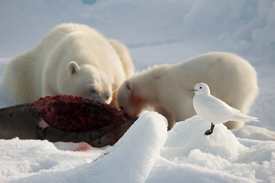 an African Lion or Leopard, the bear seemed to react to this trespass and turned, driving off the gulls and reclaiming the kill. Once she did so she seemed to settle in, and began to feed, pulling at the hide and slowly stripping the skin backwards, exposing the blubber, the most prized portion of a meal. The cub would join her, sometimes pushing between her legs, sometimes feeding side-by-side, and sometimes at opposite ends, where the cub nosed about on bloody snow while the mother continued her dissection.
an African Lion or Leopard, the bear seemed to react to this trespass and turned, driving off the gulls and reclaiming the kill. Once she did so she seemed to settle in, and began to feed, pulling at the hide and slowly stripping the skin backwards, exposing the blubber, the most prized portion of a meal. The cub would join her, sometimes pushing between her legs, sometimes feeding side-by-side, and sometimes at opposite ends, where the cub nosed about on bloody snow while the mother continued her dissection.
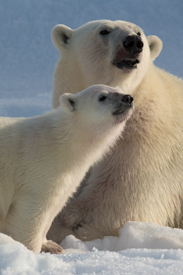 I couldn’t identify the seal at the time, but later, in looking at the images, I could see the distinctive curled whiskers distinguishing a Bearded Seal. In those grisly shots, much of the face and skull cap are gone, but the muzzle and whiskers are visible. Later, as the skin was pulled down further, only the tips of the front flippers are visible, while the forefront of the seal glowed a dull red against the snow.
I couldn’t identify the seal at the time, but later, in looking at the images, I could see the distinctive curled whiskers distinguishing a Bearded Seal. In those grisly shots, much of the face and skull cap are gone, but the muzzle and whiskers are visible. Later, as the skin was pulled down further, only the tips of the front flippers are visible, while the forefront of the seal glowed a dull red against the snow.
Early on in the feeding the female moved a short distance away and began to dig, appearing as if to dig a hole to hide. Instead, she simply made a little scrape or depression, where she settled in with her rump, allowing her to sit upright and lie back, the classic pose for nursing, and her cub immediately settled in to suckle from one, then another, of her four teats. Although the cub was born in December and was now barely six months old, it supplemented its diet of milk with licking and tugging at the seal blubber.
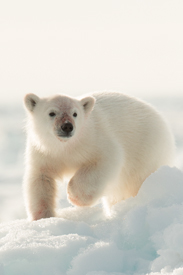 (cub, left, by Tom Wester)
(cub, left, by Tom Wester)
Like all far northern bears, polar bears mate in late spring or summer but do not give birth until December or January, when the female, inside her den, lies in a stupor but is not hibernating. Most large predatory mammals have a gestation period of only 120 days or so (lions, tigers, and leopards, for example are about 110 days, while smaller cats, and most Canines (wolves and dogs) have 60 days or so. Pregnant for six months, one would think that the baby bear should be huge, but in fact polar bear cubs, at about 1 to 1.5 pounds, are the smallest baby in relative to the potential adult size. The largest polar bear male ever recorded weighed a ton, 2000 lbs, so, potentially, the baby grew 2,000 times larger from birth to adult 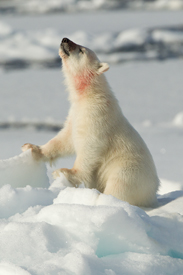 weight! Baby bears are not large at birth because the actual gestation time is similar to other predators, 120 days or so, although the bear may be pregnant for 5 to 8 months. This is due to delayed implantation, where a fertilized egg lies in the uterus but is not implanted into the uterus wall until much later. Until then, the egg lies in a state of suspended animation, and will only be implanted if, or when, the female is fat and healthy enough to sustain a pregnancy. If she is not, the egg isn’t implanted and is, instead, aborted.
weight! Baby bears are not large at birth because the actual gestation time is similar to other predators, 120 days or so, although the bear may be pregnant for 5 to 8 months. This is due to delayed implantation, where a fertilized egg lies in the uterus but is not implanted into the uterus wall until much later. Until then, the egg lies in a state of suspended animation, and will only be implanted if, or when, the female is fat and healthy enough to sustain a pregnancy. If she is not, the egg isn’t implanted and is, instead, aborted.
We shot the bear from every angle, with the first mate positioning the boat for front, side, and back lighting. Adam and David opened up the ship’s portholes and all of us took turns shooting out the ice-level windows at the bears, feeding just thirty yards or so from our ship. For much of this time the bears were backlighted against the sun, and the blue-gray shadowed forms contrasted beautifully with the bright, golden rim light of the sun, hanging low in the sky of the summer’s 24 hour day.
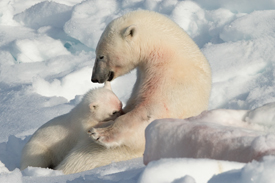 We stayed with the bears for 2.5 hours, and when the female started dragging the now nearly completely skinned seal away from the ship our guides felt she was telling us that she had had enough of us. We didn’t argue, and we were sated as well, and although each minute offered some different angle we felt we’d covered the subject thoroughly and the shooting, and this bear, were becoming redundant. We were exhausted, too, as it was now about 5AM. Nearly everyone was in danger of being out of CF cards, too, with one shooter going through four 32 gb cards, another shooting 90 gb, and others at least 70 gb. I didn’t tally my gb, but I did shoot about 3,500 images, John shot over 4,200 images, and Mary shot 3,253 images!
We stayed with the bears for 2.5 hours, and when the female started dragging the now nearly completely skinned seal away from the ship our guides felt she was telling us that she had had enough of us. We didn’t argue, and we were sated as well, and although each minute offered some different angle we felt we’d covered the subject thoroughly and the shooting, and this bear, were becoming redundant. We were exhausted, too, as it was now about 5AM. Nearly everyone was in danger of being out of CF cards, too, with one shooter going through four 32 gb cards, another shooting 90 gb, and others at least 70 gb. I didn’t tally my gb, but I did shoot about 3,500 images, John shot over 4,200 images, and Mary shot 3,253 images!
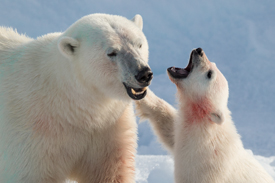 We headed for bed, awoke for an 8AM breakfast, ate, and slept until lunch! Our day seemed completely disoriented, as we then headed out for a zodiac cruise through the ice floes, where all of us landed on the ice for that unique experience, and a group photo. When we returned, at 4, we were served our usual 4PM sweets, but I think all of us thought it was a mid-morning, and therefore unusual, snack! We continued on to a shelf of fast ice (ice still locked firmly to the land) where the captain broke into the ice to secure us in hopes that during the evening or through the night a bear would pass by along the ice edge. None did, and at 1:30AM Adam awoke me to say we were moving out, as the weather had changed and the fast ice was breaking up. We headed south, sleeping and periodically awakening by the crashing, grating ice we encountered as we sailed. Our hopes was to visit another walrus colony but when we arrived the beaches were empty, and we continued south and west, heading towards more fast ice and the potential for more bears.
We headed for bed, awoke for an 8AM breakfast, ate, and slept until lunch! Our day seemed completely disoriented, as we then headed out for a zodiac cruise through the ice floes, where all of us landed on the ice for that unique experience, and a group photo. When we returned, at 4, we were served our usual 4PM sweets, but I think all of us thought it was a mid-morning, and therefore unusual, snack! We continued on to a shelf of fast ice (ice still locked firmly to the land) where the captain broke into the ice to secure us in hopes that during the evening or through the night a bear would pass by along the ice edge. None did, and at 1:30AM Adam awoke me to say we were moving out, as the weather had changed and the fast ice was breaking up. We headed south, sleeping and periodically awakening by the crashing, grating ice we encountered as we sailed. Our hopes was to visit another walrus colony but when we arrived the beaches were empty, and we continued south and west, heading towards more fast ice and the potential for more bears.
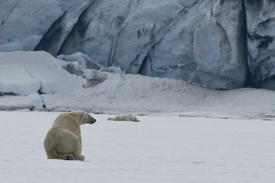

Photos, above, by Jack Fumaura
Day 6. We passed through Freemansundet Sound, a large channel that separates the two southeastern-most large islands, passing a known walrus haul out beach once we cleared the channel. No walruses were present and we continued across Storfjorden, the sea between the two islands, arriving in early afternoon to reach fast ice and a glacier face where we hoped to find bears.
We landed on the fast ice after spotting two bears, while a third arrived unexpectedly onshore after we had landed, catching us by surprise and thus missing a chance for a bear along the shoreline. The bears were hunting Ringed Seals, several of which were lying about near escape holes that were used whenever a bear came close. All of our shots were at quite a distance, although with the glacial wall as a background the images were interesting. 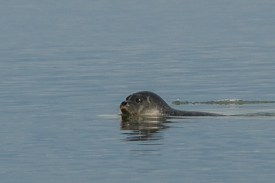 A few Ringed Seals swam close, and had we had our long lenses along we’d have had some fairly decent images, but we’d left them behind to have space for maneuvering if we’d encounter a bear along the shoreline. In all, we spent 5 hours either cruising with the zodiacs or waiting on the ice, and dressed quite warmly we were all comfortable.
A few Ringed Seals swam close, and had we had our long lenses along we’d have had some fairly decent images, but we’d left them behind to have space for maneuvering if we’d encounter a bear along the shoreline. In all, we spent 5 hours either cruising with the zodiacs or waiting on the ice, and dressed quite warmly we were all comfortable.
We had hoped to find bears wandering the ice edge, where shorter lenses would be more applicable than having long lenses along. Adam had suggested bringing the backpacks and long lenses for photographing bears further out on the pack ice but, if bears approached, we’d need to evacuate fast, which might have been problematic. I suggested that we just use our shorter lenses, but in retrospect, after seeing the images in our group slide show (two evenings later) very long lenses may have been helpful. Although heavily cropped, the images were surprisingly effective, with fair size bears against the glacial wall. As it was, however, small bears in big landscapes were quite good, too, and perhaps our luck would have been different, with  a curious bear racing towards us and stampeding us in chaos into the zodiacs. You just never know.
a curious bear racing towards us and stampeding us in chaos into the zodiacs. You just never know.
After dinner six people went back out, including Mary, while I stayed behind, my back a bit jarred from a hard bump on the zodiac as we returned to the ship. Unfortunately no bears came close, although the experience, again watching bears on the ice, was priceless. One of the bears, a female, was quite active, stalking back and forth nearly the entire glacier face as she hunted seals. One of the males was a ‘Bingo Bear,’ marked in spray paint with an identifying number, 57.
Day 7. After everyone returned to the ship last evening we headed south, intending to travel around the southern tip of Svalbard and then head north, to arrive in the early hours tomorrow for a final cruise of the fjords before returning to Longyearbyen. En route we had another Humpback Whale, which offered a few tantalizing tail flukes, after first nearly breaching and thus getting our hopes up, while a small group of Harp Seals bobbed their heads high above the water momentarily, then disappeared from sight.
We arrived in the fjords to the north and east of Longyearbyen where we hoped to encounter more fast ice, and perhaps more bears. To date we had had poor luck with seals, in contrast to last year where we had several good encounters with Bearded Seals. This year, I’d photographed just one living seal, a brief opportunity as our ship sailed by as the seal basked on an ice floe, then slipped into the sea. Two days ago we had the tantalizing glimpse of few Ringed Seals that, had we had big lenses ashore, would have offered pretty nice shots. Today, however, all that would change.

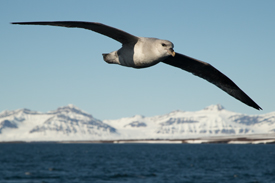
Last year, this fjord gave us our best opportunities for Northern Fulmars, that sometimes sailed by in massive flocks. We were not disappointed this year, as soon after breakfast everyone was on deck photographing fulmars as they glided by, sometimes so close that their wings could almost touch an outstretched hand. While some shooters used long lenses, I and a few others tried using wide-angle lenses to incorporate the stony cliff slopes and glacial ice into the scene. Some of us were quite successful, and at 24-40mm  I often had birds so close that the leading wing swept over my field of view.
I often had birds so close that the leading wing swept over my field of view.
Judy climbed up into the Crow’s Nest for a unique vantage point, where she shot the boat and some fulmars as they sailed below her. I didn’t try this year because of my back, but I was tempted. As we cruised into the fjord, passing through open water and thin ice, we drifted in quite slowly on a Ringed Seal that lay upon an ice floe. Three times, as we inched closer, the seal humped  over to enter the water, each time pausing for a moment to peer in, its head submerged, but then deciding not, and rather frantically reversing itself to lumber back onto the ice. We wondered what it was seeing, or whether the throbbing vibration of our ship’s engines was intensified underwater and dissuaded the seal from entering. As it was, we got to within frame-filling distance before the seal finally decided to slide back into the icy water.
over to enter the water, each time pausing for a moment to peer in, its head submerged, but then deciding not, and rather frantically reversing itself to lumber back onto the ice. We wondered what it was seeing, or whether the throbbing vibration of our ship’s engines was intensified underwater and dissuaded the seal from entering. As it was, we got to within frame-filling distance before the seal finally decided to slide back into the icy water.
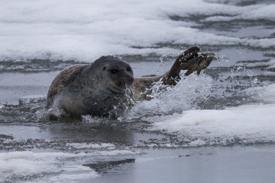 While on the ice, the Ringed Seal showed us, however briefly, a glimpse of its movement beneath the water. True seals, defined by lacking external ears and having hind flippers that extend backwards, paralleling the lines of the seal’s body, and that are not used in locomotion on land, swim in quite a unique way. Most mammals, whether we’re considering whales and dolphins or river otters, or human swimmers for that matter, swim by an undulating motion, up and down rather than side to side like a fish. Fish could be said to wiggle through the water by contrast. Even whales, the most fish-like mammals, swim with the up/down movement, although that is done only with the tail, with the front flippers, or pectoral fins, used mostly for steering. True seals swim differently.
While on the ice, the Ringed Seal showed us, however briefly, a glimpse of its movement beneath the water. True seals, defined by lacking external ears and having hind flippers that extend backwards, paralleling the lines of the seal’s body, and that are not used in locomotion on land, swim in quite a unique way. Most mammals, whether we’re considering whales and dolphins or river otters, or human swimmers for that matter, swim by an undulating motion, up and down rather than side to side like a fish. Fish could be said to wiggle through the water by contrast. Even whales, the most fish-like mammals, swim with the up/down movement, although that is done only with the tail, with the front flippers, or pectoral fins, used mostly for steering. True seals swim differently.
These seals flip their huge flippers (there are two, just like any mammal with hind legs) vertically, and propel themselves forward by side-to-side  movements, just like a fish. Walruses, with a hind limb structure similar to Sea Lions, also use this method, which is surprisingly, since their outward shape more closely resembles a Sea Lion. Walruses are true transitional forms between the True Seals and the Eared Seals, as they, like True Seals, lack external ears and swim similarly, while their limbs are positioned much like an Eared Seal, and they are capable of ‘walking’ across sand like a Sea Lion, though they rarely do so. Eared Seals, in contrast, use their powerful front flippers for propulsion, flashing through the water much like penguins.
movements, just like a fish. Walruses, with a hind limb structure similar to Sea Lions, also use this method, which is surprisingly, since their outward shape more closely resembles a Sea Lion. Walruses are true transitional forms between the True Seals and the Eared Seals, as they, like True Seals, lack external ears and swim similarly, while their limbs are positioned much like an Eared Seal, and they are capable of ‘walking’ across sand like a Sea Lion, though they rarely do so. Eared Seals, in contrast, use their powerful front flippers for propulsion, flashing through the water much like penguins.
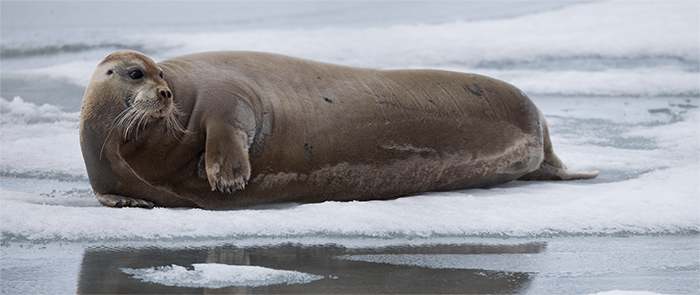
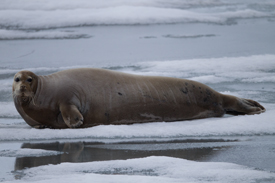 Not too much later we encountered a Bearded Seal on the ice and typical for this species it was much more tolerant, allowing our boat to get closer than frame-filling distance before it slid off the ice. Up close, the difference between the two is quite obvious. Besides having the indistinct rings and chevrons giving the Ringed Seal its name, the seal has a proportionately larger head and when it raises its head
Not too much later we encountered a Bearded Seal on the ice and typical for this species it was much more tolerant, allowing our boat to get closer than frame-filling distance before it slid off the ice. Up close, the difference between the two is quite obvious. Besides having the indistinct rings and chevrons giving the Ringed Seal its name, the seal has a proportionately larger head and when it raises its head
up, the shape is like a thick comma (,) lying on its side. Bearded Seals have a smaller head and longer, unmarked body, and Adam likened it to a brown sleeping bag. We saw this, inside out, at the polar bear kill where that Bearded Seal carcass was turned inside out!
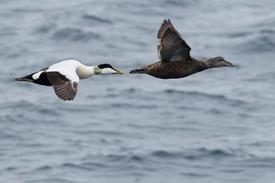 At 4PM we did a long, cold zodiac cruise around a few islands where we saw and/or photographed Red Phalaropes, Arctic Terns, Common Eiders, and less successfully, Red-throated Divers (Loons), King Eiders, Long-tailed (Oldsquaw) Ducks, and Purple Sandpipers. The seas were very calm but the air was chill, and all of us were thoroughly cooled by the time we raced back to the ship.
At 4PM we did a long, cold zodiac cruise around a few islands where we saw and/or photographed Red Phalaropes, Arctic Terns, Common Eiders, and less successfully, Red-throated Divers (Loons), King Eiders, Long-tailed (Oldsquaw) Ducks, and Purple Sandpipers. The seas were very calm but the air was chill, and all of us were thoroughly cooled by the time we raced back to the ship.
That evening, after a sumptuous dinner of exquisitely cooked beef filet, we had a nearly 600 image slide show, a great portfolio of the week’s shoot and ‘loosely’ based on a film Adam had shown us, ‘An Enemy to Die For,’ a WWII action/drama filmed on our ship, the Stockholm. Our’s was ‘A Shooter to Die For,’ where Judy and Mary systematically eliminated everyone on the ship, leaving only me as the survivor. The captions told the story, although the crew may not have appreciated the humor as much as we did – as Mary had killed off the crew!
 Day 8. We arrived in Longyearbyen before we went to bed last night, enjoying a silent, motionless ship for our last night aboard. Morning greeted us with a cloudless blue sky and clement temperatures, although the forecasted high for later in the week in northern Svalbard is supposed to be -17 Centigrade! We spent our morning in the lounge of the Radisson, reading and doing email before beginning our journey home. Just like last year, no one was really ready to leave, and several were planning on returning again next year for the next trip! This one was, I believe, the most successful of the three we’ve done, although each, in different ways, offered subjects or encounters not experienced on other trips. That is the beauty of the Arctic, and nature, it is never the same.
Day 8. We arrived in Longyearbyen before we went to bed last night, enjoying a silent, motionless ship for our last night aboard. Morning greeted us with a cloudless blue sky and clement temperatures, although the forecasted high for later in the week in northern Svalbard is supposed to be -17 Centigrade! We spent our morning in the lounge of the Radisson, reading and doing email before beginning our journey home. Just like last year, no one was really ready to leave, and several were planning on returning again next year for the next trip! This one was, I believe, the most successful of the three we’ve done, although each, in different ways, offered subjects or encounters not experienced on other trips. That is the beauty of the Arctic, and nature, it is never the same.
Read about our 2013 trip, or our 2012 Scouting Trip.
Read our 2014 brochure. Information applies for 2015,
for reference.
Polar Bears and the Wildlife
of Svalbard
Photo Tour
June 2014
Trip Report




Polar Bear and cub;
Arctic Tern; Atlantic Walruses with a very young pup.
Mother and Cub; Bear on the fast ice near a glacier
.


This trip was the third Mary and I have made to our northernmost destination, within 500 miles of the North Pole and far above the Arctic Circle. For those who know Polar Bears, the name Svalbard, or Spitsbergen as it was once called, is synonymous, as bears den, stalk the shorelines, and roam the pack ice and broken ice floes here, making this location a true Arctic experience.
 In truth, we thought it might be our last for a while, as the financial risk involved in making a huge deposit to secure what most everyone believe is the best ship to tour the archipelago is extreme. However, the lure of the Arctic and the wonderful shooting and natural history experiences were too much, and we secured our boat again for next year.
In truth, we thought it might be our last for a while, as the financial risk involved in making a huge deposit to secure what most everyone believe is the best ship to tour the archipelago is extreme. However, the lure of the Arctic and the wonderful shooting and natural history experiences were too much, and we secured our boat again for next year.
We sailed on a ship called the Stockholm, with a length of only 75 feet, limited to only 12 passengers, and, most importantly, with a deck that is so low that a bear, if we were moored  on ice, could touch or reach into the deck with its paw. Consequently, low level shooting is easy, and this year, with one of our bear encounters, we went one step better, photographing from open portholes that put us at eye-level with a bear as she and her cub fed upon a fresh Bearded Seal kill. It was an exquisite experience.
on ice, could touch or reach into the deck with its paw. Consequently, low level shooting is easy, and this year, with one of our bear encounters, we went one step better, photographing from open portholes that put us at eye-level with a bear as she and her cub fed upon a fresh Bearded Seal kill. It was an exquisite experience.
 Traveling in early June, just weeks before the Summer Solstice and the longest day of the year, the sun never set and, on 'all-night' shoots with polar bears
the time can be almost disorienting, as after a full night of shooting, sleeping two hours before breakfast, and sleeping again until lunch, when another full day continued, it was as if we had had two days crammed into one. Our Expedition Leaders this year were superb, incredibly high-energy guys who, when we were in the ice or in bear country, would remain for hours in the Crow's Nest watching for bears, and how, indeed, the two best sightings were made.
Traveling in early June, just weeks before the Summer Solstice and the longest day of the year, the sun never set and, on 'all-night' shoots with polar bears
the time can be almost disorienting, as after a full night of shooting, sleeping two hours before breakfast, and sleeping again until lunch, when another full day continued, it was as if we had had two days crammed into one. Our Expedition Leaders this year were superb, incredibly high-energy guys who, when we were in the ice or in bear country, would remain for hours in the Crow's Nest watching for bears, and how, indeed, the two best sightings were made.
 This trip always offers more than just bears, and I think we're the only tour that rents vehicles (until our competitors read this, of course) for drives into the countryside where we photograph Eider Duck, Rock Ptarmigan, Reindeer, and any other species we encounter. On my 'scouting trip' here a few years ago we had to walk to where ever we were going, a major inconvenience and hassle when you are carrying big lenses, or hoping to see all that Svalbard has to offer. By renting vehicles, we could do just that!
This trip always offers more than just bears, and I think we're the only tour that rents vehicles (until our competitors read this, of course) for drives into the countryside where we photograph Eider Duck, Rock Ptarmigan, Reindeer, and any other species we encounter. On my 'scouting trip' here a few years ago we had to walk to where ever we were going, a major inconvenience and hassle when you are carrying big lenses, or hoping to see all that Svalbard has to offer. By renting vehicles, we could do just that!
On last year's trip, northern winds pushed the pack ice south, and almost cut off our route to return to port. This year, as we've found almost everywhere in the world we've visited, the spring was cold, and this applied to Svalbard as well. When we arrived, the northernmost portion of the archipelago, and the route we normally travel, was closed, blocked by the arctic ice pack. Our only option was to travel south, then east-northeast to reach exciting new country, and to hit the pack ice that still lingered near one of the major bear denning areas in Svalbard. Although that area is off-limits, the ice that surrounded the islands and extended far out to sea had bears, and here we had our most incredible encounters.
 But as always, the trip offered more than just bears, with incredible scenics, great Atlantic Walruses, Bearded and Ringed Seals, Northern Fulmars, and many other birds all being a part of the shooting experience.
But as always, the trip offered more than just bears, with incredible scenics, great Atlantic Walruses, Bearded and Ringed Seals, Northern Fulmars, and many other birds all being a part of the shooting experience.
Our traveling north went smoothly, and no one was hassled at the airports about our gear. Mary and I carried our equipment in Gura Gear Bataflae bags, as did several others, while some, with lighter gear, used the Kiboko bags. In addition to using the Bataflae bags for our air travel, we also used the bags when we would land. Mary's could keep a camera mounted on her 500mm (with the hood reversed) inside the bag, while my longer 800mm fit inside, with the hood reversed, but I had to mount the camera on once I got ashore. Mary and I used our Really Right Stuff tripods, and Wimberley Model II gimbal heads, which worked quite effectively on the deck of the ship. In the zodiacs we hand-held our gear, Mary often using a 28-300mm and I used a 70-300mm for the wildlife shots. Because I now own an 800mm I used it, but most folks used 500mm, or 200-400mms, or 100-400mms, for the shooting. As usual, I was shooting with Hoodman CF cards, and normally I'm using the latest card, a 64 gb speed demon. However, on one occasion I had another, older version mounted instead, and I was wondering why I was occasionally buffering out as I shot 12fps bursts. That normally doesn't happen, and I was puzzled, so I opened the camera and saw the older card. I quickly changed, and the new CF cards are blazingly fast and I never buffered out. I loved the old Hoodmans, but the new ones, a UMDA 7, 1000X, are simply incredible.
I'm getting a head of myself here, as some of this will be repeated in the trip report, that follows, below!
Day 1. Longyearbyen
We arrived in Longyearbyen on time, with everyone arriving in Oslo at least one day before this morning flight. We learned, after last year, when we flew SAS and still nearly missed the flight, with the slow processing of tourists at the airport. Arriving in plenty of time, this year, we had no trouble, especially since, with my back, I asked if I could board early, was okayed, and nearly everyone in our group simply followed me on! That was fortunate, as the flight was full and overhead space became precious.
After checking in to our hotel (the Svalbard Hotel), we had a mid-afternoon lunch in preparation for a drive into the countryside to look for birds and wildlife. On the gangplank-like steps of the nearby restaurant Dave slipped, and so severely jammed his foot that he thought he had broken it, although he didn’t say anything at the time.
Although the skies were overcast and the light was decent, and we drove out the mile to the dog kennels where, under the barking protection of sledge dogs to keep Arctic fox at bay, dozens of Common Eiders nest. We photographed birds posing, swimming, and, tossing their heads back in a quick grunt, calling.  A Parasitic Jaeger flew over frequently, circling the nesting colony as this northern skua looked for vulnerable eggs or the first chicks of the year. It was unsuccessful, but the bird did give us a few fleeting opportunities for shots. Barnacle Geese not only spotted the tidal flats below the colony but were also, this year, mixed within, giving us the best opportunities we’ve had for close-ups of this white-faced, Brant-like goose.
A Parasitic Jaeger flew over frequently, circling the nesting colony as this northern skua looked for vulnerable eggs or the first chicks of the year. It was unsuccessful, but the bird did give us a few fleeting opportunities for shots. Barnacle Geese not only spotted the tidal flats below the colony but were also, this year, mixed within, giving us the best opportunities we’ve had for close-ups of this white-faced, Brant-like goose.
We continued out of town, looking for, and soon finding, Reindeer. One fairly good buck, its antlers still in velvet, was fairly close to the road and cooperated well. A great example of Allen’s (or Bergman’s?) rule, where in northern climates limbs and extremities shorten to conserve heat, the reindeer’s legs are very short, giving the animal a stout, barrel-like appearance.


King Eider, left; Common Eider, right.
Heading back towards town I spotted a pair of King Eiders who swam fairly close to shore, and continued swimming parallel to us until they found a gap in the bay where they could head away. Several Purple Sandpipers plumbed the shoreline mud, close enough that we could read their color-coded bands,  and two Red Phalaropes, the females brightly colored in red and white markings, swam nearby along the shoreline. Phalaropes are one of the few birds where the females are polyandrous, mating with several males, who are stuck with incubating the eggs and caring for the precious young. Like all shorebirds, the chicks are well-developed upon hatching, and are immediately mobile and able to feed themselves, although they mimic and observe their sole parent, the male.
and two Red Phalaropes, the females brightly colored in red and white markings, swam nearby along the shoreline. Phalaropes are one of the few birds where the females are polyandrous, mating with several males, who are stuck with incubating the eggs and caring for the precious young. Like all shorebirds, the chicks are well-developed upon hatching, and are immediately mobile and able to feed themselves, although they mimic and observe their sole parent, the male.
Our last target species for the day was the extremely well-camouflaged  Rock Ptarmigan, a high country grouse that, like all members of the Ptarmigan family, turn white in winter and brown, or gray in the case of the Rock, in summer. Jack spotted a female near the road and soon we found another, and a nearly pure white male that flew down the mountain slope to join Jack’s female. As he landed in the snow he flared his black outer tail feathers in display, but soon folded those feathers, revealing only his vivid, erect comb of red flesh above his eyes. The birds were incredibly tame and although it appeared as if they were about to mate the female always scurried away and, chastened, the male’s red display crest slowly receded.
Rock Ptarmigan, a high country grouse that, like all members of the Ptarmigan family, turn white in winter and brown, or gray in the case of the Rock, in summer. Jack spotted a female near the road and soon we found another, and a nearly pure white male that flew down the mountain slope to join Jack’s female. As he landed in the snow he flared his black outer tail feathers in display, but soon folded those feathers, revealing only his vivid, erect comb of red flesh above his eyes. The birds were incredibly tame and although it appeared as if they were about to mate the female always scurried away and, chastened, the male’s red display crest slowly receded.
We returned to our hotel where we discovered Dave was hurting far more than he let on, and Mary and I took him to the town’s hospital where a doctor had to be called in, since it was after 4. Dave’s foot wasn’t broken, just badly stressed, but the doctor did provide some entertainment as he displayed little humor, a very Prussian attitude, and a sense of shock when, one, Mary wrote Dave’s birth date the US way, with the month first, and two, when he discovered none of us had a cell phone! His silent stare as he looked at us, silently, for each of these transgressions was priceless.
Day 2. Although the sun never sets, our ‘morning’ dawned clear, with an almost cloudless sky, and we repeated the agenda from yesterday, shooting the Eider ducks, Reindeer, and Ptarmigan again. After lunch we visited the  museum where most of us fell asleep on the seal rugs laid out in the reading area, the bunch of us resembling a group of hauled-out walruses on a beach. (Photo, Tom Wester)
museum where most of us fell asleep on the seal rugs laid out in the reading area, the bunch of us resembling a group of hauled-out walruses on a beach. (Photo, Tom Wester)
At 3:30 we walked to the boat dock where we met the guides and crew, and by 6 left port for our journey south.
Last year, as we had the year before as well, we had traveled north, but the ice this year covered the northern portions of the island, making our usual stops impossible. The boats previous trip had been to the south as well, and they did quite well, and we were excited as this would be new country for us, and would go to the ice pack where bears are common. Our sea travel that night went uneventfully, with extremely calm seas.


Day 3. We dropped anchor before breakfast at one of the southernmost fjords on the main island, at Burgebudte, where several glaciers meet the sea in a three branched fjord. At 9:30 we did a zodiac cruise, hoping to encounter polar bears, as a few spend the year here and we saw their tracks several times. Old tracks were unique, as they were actual casts, as the bear’s weight compressed the snow such that as the surrounding snow, uncompressed, melted, the more solid snow from the tracks remained, creating weird, raised steps, like a series of cement blocks, traipsing across the snow fields. Fresh tracks were, as expected, indented into the snow, but none led to a bear.
 (Jack with the glacier, Adam Rheborg photo)
(Jack with the glacier, Adam Rheborg photo)
At the face of one of the glaciers, from nearly 300 yards away, we motored about in the zodiacs as the glacier began to calve, at first dropping snow blocks (perhaps the size of cars) into the sea with rifle-crack blasts. One ridge had constant action, with little landslides suddenly popping into view, preceded by the loud blasts of breaking ice. Eventually, as we had hoped, the entire wall crumbled, sliding into the sea, and followed by a chain reaction as more and more ice broke off from the glacial face and crashed into the frigid waters.


Photo on right by Bill Sailer
A tsumami formed, and our guide turned the zodiac to speed off, fearing that the huge wave might crest if the pulse of water passed over a shallow reef. Fortunately it did not, but we rode huge swells as the wave passed under us. It was, without a doubt, the best calving we’d ever seen, and certainly never as close.


Arctic Terns; Black-legged Kittiwakes
Although we saw only one Harbor Seal, we had extremely good luck with a rare species of gull, the Ivory Gull, a species associated only with the ice and famous for living off the scraps of bear kills. Our bird, black legged with a a gray-black bill, was extremely cooperative and only took flight when two Black-legged Kittiwakes (a small gull species) flew in to join the gull, then took off, taking our Ivory gull with them. We also photographed several groups of cooperative Northern Fulmars as they perched on ice floes, framed by the glacial face behind.


Atlantic Puffin; Thick-billed Murre
After lunch we continued exploring the fjords, hoping to find a bear but without success, although we did photograph more Fulmars, a few Common Puffins, and spectacular landscapes. At 5 most of us were down-loading when one of the A-Bs, Able-bodied Seamen, ran down to tell us a Humpback  Whale was spotted. We spent the next hour with the whale, who began with some unexpected tail-slapping, but later only did some nice, and very close, soundings, where its distinctive tail pattern was visible.(photo, Judy Johnson)
Whale was spotted. We spent the next hour with the whale, who began with some unexpected tail-slapping, but later only did some nice, and very close, soundings, where its distinctive tail pattern was visible.(photo, Judy Johnson)
By 6:30 we were heading south, soon to reach the southernmost tip of Svalbard before heading across the open seas to reach the eastern island of the archipelago, new land for all of us.
 Day 4. Our unexpected visit with the Humpback whale potentially cost us time to the East, so we planned a brunch at 9:30 with an expected landfall at Bjombuka, for Atlantic Walruses, around noon. Fortunately, during the night a strong westerly wind propelled our ship forward against the current, gaining us the hour we had lost yesterday with the whale. Accordingly, we had an earlier breakfast, and a landfall, via zodiac, by 9:30AM.
Day 4. Our unexpected visit with the Humpback whale potentially cost us time to the East, so we planned a brunch at 9:30 with an expected landfall at Bjombuka, for Atlantic Walruses, around noon. Fortunately, during the night a strong westerly wind propelled our ship forward against the current, gaining us the hour we had lost yesterday with the whale. Accordingly, we had an earlier breakfast, and a landfall, via zodiac, by 9:30AM.
 The walrus haul out was quite large, extending about two hundred yards along the beach, divided into two pods, with one mostly males and the other a mixture of males and a few females with calves. The calves were born less than a month ago, at around 80 kg, and although still quite young they looked much like the adults, except for a lack of tusks. Babies remain with their mothers for up to 2.5 years, in contrast to most seals (of either family or major division) where the babies are nursed or cared for for a few weeks at most. In fact, the Hooded Seal, one of the largest species, has the record for any mammal, weaning the baby in just four days.
The walrus haul out was quite large, extending about two hundred yards along the beach, divided into two pods, with one mostly males and the other a mixture of males and a few females with calves. The calves were born less than a month ago, at around 80 kg, and although still quite young they looked much like the adults, except for a lack of tusks. Babies remain with their mothers for up to 2.5 years, in contrast to most seals (of either family or major division) where the babies are nursed or cared for for a few weeks at most. In fact, the Hooded Seal, one of the largest species, has the record for any mammal, weaning the baby in just four days.


On the last trip to this haul out, Adam, our guide, watched as four Reindeer swam across the bay from a nearby island towards this beach. One hundred yards out a walrus suddenly rose and stabbed the reindeer, probably mistaking it for a polar bear. It killed it instantly, leaving a hatchet-like divot in the ribcage, where one of the lungs floated free. We didn’t see any violence today, although at the end of the visit, while we motored about in a zodiac watching some young males play-fighting, a torpedo-like wake sped towards us, a charging walrus swimming beneath the waves. Adam jumped to the front with a paddle, intending to bump its nose should it make contact, but the walrus lost its nerve at the last moment and swerved, thrashing the water in big splashes as it did so.
 I was surprised at how uncaring the walruses were to our presence. At previous haul-outs, perhaps because they are more frequently visited and thus disturbed, walruses often ambled, or rushed, towards the sea. These did not, although perhaps the difference was that Adam spoke loudly, letting the walruses know we were present. Memory fails me here, but I believe that we moved in rather quietly on other trips, and perhaps suddenly surprised the walruses with our unexpected appearance when they awoke. At any rate, none of the walruses showed any sign of disturbance, and we circled about, fortunately getting upwind and on the sunny side of the groups. En route, the smell was quite strong, and one can truly say that a group of walruses really do stink!
I was surprised at how uncaring the walruses were to our presence. At previous haul-outs, perhaps because they are more frequently visited and thus disturbed, walruses often ambled, or rushed, towards the sea. These did not, although perhaps the difference was that Adam spoke loudly, letting the walruses know we were present. Memory fails me here, but I believe that we moved in rather quietly on other trips, and perhaps suddenly surprised the walruses with our unexpected appearance when they awoke. At any rate, none of the walruses showed any sign of disturbance, and we circled about, fortunately getting upwind and on the sunny side of the groups. En route, the smell was quite strong, and one can truly say that a group of walruses really do stink!
 The beach was littered with the disintegrating vertebrae and partial skulls of walruses slaughtered not that long ago … in 1952, the year I was born, walruses in Svalbard were finally protected. In 2007 a census counted approximately 3,000 walruses, although at the time of protection finding ANY on the islands was a rarity. Today, there may be nearly twice that number, and Adam hopes that one day they’ll litter the beach en masse, as they probably did before Europeans wiped them out for oil, ivory, and eventually hides, used in making industrial belts for machinery.
The beach was littered with the disintegrating vertebrae and partial skulls of walruses slaughtered not that long ago … in 1952, the year I was born, walruses in Svalbard were finally protected. In 2007 a census counted approximately 3,000 walruses, although at the time of protection finding ANY on the islands was a rarity. Today, there may be nearly twice that number, and Adam hopes that one day they’ll litter the beach en masse, as they probably did before Europeans wiped them out for oil, ivory, and eventually hides, used in making industrial belts for machinery.
We had several swim close to the beach to investigate, and in the distance young males fought in the surf. Twice Arctic Terns flew close by and dove for  fish, and a pair of Oldsquaws, not politically correctly called Long-tailed Ducks, occupied a small pond along the beach. After two hours or so we headed back to our ship, continuing to the Northeast and on to polar bear country.
fish, and a pair of Oldsquaws, not politically correctly called Long-tailed Ducks, occupied a small pond along the beach. After two hours or so we headed back to our ship, continuing to the Northeast and on to polar bear country.
(Photo, Don Lewis)
Day 5. Hoping for the best, Mary and I stayed up late, fruitlessly wasting time watching for bears in what was, essentially, an open sea, as ice floes were small and scattered. By mid-night we had gone to bed, only to be awakened at 1:30AM by Adam, who had spent the last three hours in the crow’s nest watching for bears. He’d spotted one, far in the distance, lying atop a snow pile on a fairly substantial  ice floe, twisted and blocky as a pressure ridge. Everyone was soon on deck as we slowly, and cautiously, approached the bear. At first the bear did nothing, lifting its head occasionally to watch our approach, but as we neared it became more animated, and when we were in great shooting distance the bear grew curious, circling about on the floe as it investigated these new scents and, it seemed, toying with the idea of actually approaching the ship. As it was, the bear was a frame-filling subject with 300mm, and the 2AM light was soft and golden, with a bear
ice floe, twisted and blocky as a pressure ridge. Everyone was soon on deck as we slowly, and cautiously, approached the bear. At first the bear did nothing, lifting its head occasionally to watch our approach, but as we neared it became more animated, and when we were in great shooting distance the bear grew curious, circling about on the floe as it investigated these new scents and, it seemed, toying with the idea of actually approaching the ship. As it was, the bear was a frame-filling subject with 300mm, and the 2AM light was soft and golden, with a bear


Bear on left by Bill Sailer


Left, by Jack Fumaura; Right, by Judy Johnson
glowing a pristine, sparkling white. Twice the bear jumped from one floe or ridge to another, and I missed them both, although several, including Mary, got some great shots.
 After 1.5 hours the bear finally moved off, unhurriedly walking away from us and entering the water without a splash. The bear swam to the north, at a speed approaching two knots, and since the protocol is to not approach a swimming bear, for fear of stressing it, we left it to continue on ourselves. We returned to our cabins, intending to get some sleep when David, our other guide, who had relieved Adam in the Crow’s Nest, spotted another bear. We headed back on deck.
After 1.5 hours the bear finally moved off, unhurriedly walking away from us and entering the water without a splash. The bear swam to the north, at a speed approaching two knots, and since the protocol is to not approach a swimming bear, for fear of stressing it, we left it to continue on ourselves. We returned to our cabins, intending to get some sleep when David, our other guide, who had relieved Adam in the Crow’s Nest, spotted another bear. We headed back on deck.
Photo, left by Adam Rheborg
Adam approached, and told me we may have struck gold – a mother bear with two cubs and a kill! As we grew closer, the female would raise her head above the pressure ridge for a brief moment, checking us out, and a cub would periodically appear, often climbing atop the snow ridge for a full view. We inched closer, eventually clearing the obstructing snow ridge and having a clear view of the  bears (a mother and one cub) and their kill, a Bearded Seal, still steaming in the cold air. Our Expedition Leaders suspected the kill was less than an hour old, and maybe fresher, and we suspect that the male bear we’d been photographing had smelled the kill and had swam off in that direction.
bears (a mother and one cub) and their kill, a Bearded Seal, still steaming in the cold air. Our Expedition Leaders suspected the kill was less than an hour old, and maybe fresher, and we suspect that the male bear we’d been photographing had smelled the kill and had swam off in that direction.
We stayed with the mother bear for about 2.5 hours, and our captain, and the First Mate once the captain took his break, did an incredible job, maneuvering the ship to provide us with several angles. At first I thought the bear might be nervous and was about to desert the kill, as she walked a short distance away from the seal, with her six month old cub bawling its complaints as she did so. With the carcass now abandoned, Glaucous and Ivory Gulls flew in to claim this free meal, and like  an African Lion or Leopard, the bear seemed to react to this trespass and turned, driving off the gulls and reclaiming the kill. Once she did so she seemed to settle in, and began to feed, pulling at the hide and slowly stripping the skin backwards, exposing the blubber, the most prized portion of a meal. The cub would join her, sometimes pushing between her legs, sometimes feeding side-by-side, and sometimes at opposite ends, where the cub nosed about on bloody snow while the mother continued her dissection.
an African Lion or Leopard, the bear seemed to react to this trespass and turned, driving off the gulls and reclaiming the kill. Once she did so she seemed to settle in, and began to feed, pulling at the hide and slowly stripping the skin backwards, exposing the blubber, the most prized portion of a meal. The cub would join her, sometimes pushing between her legs, sometimes feeding side-by-side, and sometimes at opposite ends, where the cub nosed about on bloody snow while the mother continued her dissection.
 I couldn’t identify the seal at the time, but later, in looking at the images, I could see the distinctive curled whiskers distinguishing a Bearded Seal. In those grisly shots, much of the face and skull cap are gone, but the muzzle and whiskers are visible. Later, as the skin was pulled down further, only the tips of the front flippers are visible, while the forefront of the seal glowed a dull red against the snow.
I couldn’t identify the seal at the time, but later, in looking at the images, I could see the distinctive curled whiskers distinguishing a Bearded Seal. In those grisly shots, much of the face and skull cap are gone, but the muzzle and whiskers are visible. Later, as the skin was pulled down further, only the tips of the front flippers are visible, while the forefront of the seal glowed a dull red against the snow.
Early on in the feeding the female moved a short distance away and began to dig, appearing as if to dig a hole to hide. Instead, she simply made a little scrape or depression, where she settled in with her rump, allowing her to sit upright and lie back, the classic pose for nursing, and her cub immediately settled in to suckle from one, then another, of her four teats. Although the cub was born in December and was now barely six months old, it supplemented its diet of milk with licking and tugging at the seal blubber.
 (cub, left, by Tom Wester)
(cub, left, by Tom Wester)
Like all far northern bears, polar bears mate in late spring or summer but do not give birth until December or January, when the female, inside her den, lies in a stupor but is not hibernating. Most large predatory mammals have a gestation period of only 120 days or so (lions, tigers, and leopards, for example are about 110 days, while smaller cats, and most Canines (wolves and dogs) have 60 days or so. Pregnant for six months, one would think that the baby bear should be huge, but in fact polar bear cubs, at about 1 to 1.5 pounds, are the smallest baby in relative to the potential adult size. The largest polar bear male ever recorded weighed a ton, 2000 lbs, so, potentially, the baby grew 2,000 times larger from birth to adult  weight! Baby bears are not large at birth because the actual gestation time is similar to other predators, 120 days or so, although the bear may be pregnant for 5 to 8 months. This is due to delayed implantation, where a fertilized egg lies in the uterus but is not implanted into the uterus wall until much later. Until then, the egg lies in a state of suspended animation, and will only be implanted if, or when, the female is fat and healthy enough to sustain a pregnancy. If she is not, the egg isn’t implanted and is, instead, aborted.
weight! Baby bears are not large at birth because the actual gestation time is similar to other predators, 120 days or so, although the bear may be pregnant for 5 to 8 months. This is due to delayed implantation, where a fertilized egg lies in the uterus but is not implanted into the uterus wall until much later. Until then, the egg lies in a state of suspended animation, and will only be implanted if, or when, the female is fat and healthy enough to sustain a pregnancy. If she is not, the egg isn’t implanted and is, instead, aborted.
We shot the bear from every angle, with the first mate positioning the boat for front, side, and back lighting. Adam and David opened up the ship’s portholes and all of us took turns shooting out the ice-level windows at the bears, feeding just thirty yards or so from our ship. For much of this time the bears were backlighted against the sun, and the blue-gray shadowed forms contrasted beautifully with the bright, golden rim light of the sun, hanging low in the sky of the summer’s 24 hour day.
 We stayed with the bears for 2.5 hours, and when the female started dragging the now nearly completely skinned seal away from the ship our guides felt she was telling us that she had had enough of us. We didn’t argue, and we were sated as well, and although each minute offered some different angle we felt we’d covered the subject thoroughly and the shooting, and this bear, were becoming redundant. We were exhausted, too, as it was now about 5AM. Nearly everyone was in danger of being out of CF cards, too, with one shooter going through four 32 gb cards, another shooting 90 gb, and others at least 70 gb. I didn’t tally my gb, but I did shoot about 3,500 images, John shot over 4,200 images, and Mary shot 3,253 images!
We stayed with the bears for 2.5 hours, and when the female started dragging the now nearly completely skinned seal away from the ship our guides felt she was telling us that she had had enough of us. We didn’t argue, and we were sated as well, and although each minute offered some different angle we felt we’d covered the subject thoroughly and the shooting, and this bear, were becoming redundant. We were exhausted, too, as it was now about 5AM. Nearly everyone was in danger of being out of CF cards, too, with one shooter going through four 32 gb cards, another shooting 90 gb, and others at least 70 gb. I didn’t tally my gb, but I did shoot about 3,500 images, John shot over 4,200 images, and Mary shot 3,253 images!
 We headed for bed, awoke for an 8AM breakfast, ate, and slept until lunch! Our day seemed completely disoriented, as we then headed out for a zodiac cruise through the ice floes, where all of us landed on the ice for that unique experience, and a group photo. When we returned, at 4, we were served our usual 4PM sweets, but I think all of us thought it was a mid-morning, and therefore unusual, snack! We continued on to a shelf of fast ice (ice still locked firmly to the land) where the captain broke into the ice to secure us in hopes that during the evening or through the night a bear would pass by along the ice edge. None did, and at 1:30AM Adam awoke me to say we were moving out, as the weather had changed and the fast ice was breaking up. We headed south, sleeping and periodically awakening by the crashing, grating ice we encountered as we sailed. Our hopes was to visit another walrus colony but when we arrived the beaches were empty, and we continued south and west, heading towards more fast ice and the potential for more bears.
We headed for bed, awoke for an 8AM breakfast, ate, and slept until lunch! Our day seemed completely disoriented, as we then headed out for a zodiac cruise through the ice floes, where all of us landed on the ice for that unique experience, and a group photo. When we returned, at 4, we were served our usual 4PM sweets, but I think all of us thought it was a mid-morning, and therefore unusual, snack! We continued on to a shelf of fast ice (ice still locked firmly to the land) where the captain broke into the ice to secure us in hopes that during the evening or through the night a bear would pass by along the ice edge. None did, and at 1:30AM Adam awoke me to say we were moving out, as the weather had changed and the fast ice was breaking up. We headed south, sleeping and periodically awakening by the crashing, grating ice we encountered as we sailed. Our hopes was to visit another walrus colony but when we arrived the beaches were empty, and we continued south and west, heading towards more fast ice and the potential for more bears.


Photos, above, by Jack Fumaura
Day 6. We passed through Freemansundet Sound, a large channel that separates the two southeastern-most large islands, passing a known walrus haul out beach once we cleared the channel. No walruses were present and we continued across Storfjorden, the sea between the two islands, arriving in early afternoon to reach fast ice and a glacier face where we hoped to find bears.
We landed on the fast ice after spotting two bears, while a third arrived unexpectedly onshore after we had landed, catching us by surprise and thus missing a chance for a bear along the shoreline. The bears were hunting Ringed Seals, several of which were lying about near escape holes that were used whenever a bear came close. All of our shots were at quite a distance, although with the glacial wall as a background the images were interesting.  A few Ringed Seals swam close, and had we had our long lenses along we’d have had some fairly decent images, but we’d left them behind to have space for maneuvering if we’d encounter a bear along the shoreline. In all, we spent 5 hours either cruising with the zodiacs or waiting on the ice, and dressed quite warmly we were all comfortable.
A few Ringed Seals swam close, and had we had our long lenses along we’d have had some fairly decent images, but we’d left them behind to have space for maneuvering if we’d encounter a bear along the shoreline. In all, we spent 5 hours either cruising with the zodiacs or waiting on the ice, and dressed quite warmly we were all comfortable.
We had hoped to find bears wandering the ice edge, where shorter lenses would be more applicable than having long lenses along. Adam had suggested bringing the backpacks and long lenses for photographing bears further out on the pack ice but, if bears approached, we’d need to evacuate fast, which might have been problematic. I suggested that we just use our shorter lenses, but in retrospect, after seeing the images in our group slide show (two evenings later) very long lenses may have been helpful. Although heavily cropped, the images were surprisingly effective, with fair size bears against the glacial wall. As it was, however, small bears in big landscapes were quite good, too, and perhaps our luck would have been different, with  a curious bear racing towards us and stampeding us in chaos into the zodiacs. You just never know.
a curious bear racing towards us and stampeding us in chaos into the zodiacs. You just never know.
After dinner six people went back out, including Mary, while I stayed behind, my back a bit jarred from a hard bump on the zodiac as we returned to the ship. Unfortunately no bears came close, although the experience, again watching bears on the ice, was priceless. One of the bears, a female, was quite active, stalking back and forth nearly the entire glacier face as she hunted seals. One of the males was a ‘Bingo Bear,’ marked in spray paint with an identifying number, 57.
Day 7. After everyone returned to the ship last evening we headed south, intending to travel around the southern tip of Svalbard and then head north, to arrive in the early hours tomorrow for a final cruise of the fjords before returning to Longyearbyen. En route we had another Humpback Whale, which offered a few tantalizing tail flukes, after first nearly breaching and thus getting our hopes up, while a small group of Harp Seals bobbed their heads high above the water momentarily, then disappeared from sight.
We arrived in the fjords to the north and east of Longyearbyen where we hoped to encounter more fast ice, and perhaps more bears. To date we had had poor luck with seals, in contrast to last year where we had several good encounters with Bearded Seals. This year, I’d photographed just one living seal, a brief opportunity as our ship sailed by as the seal basked on an ice floe, then slipped into the sea. Two days ago we had the tantalizing glimpse of few Ringed Seals that, had we had big lenses ashore, would have offered pretty nice shots. Today, however, all that would change.


Last year, this fjord gave us our best opportunities for Northern Fulmars, that sometimes sailed by in massive flocks. We were not disappointed this year, as soon after breakfast everyone was on deck photographing fulmars as they glided by, sometimes so close that their wings could almost touch an outstretched hand. While some shooters used long lenses, I and a few others tried using wide-angle lenses to incorporate the stony cliff slopes and glacial ice into the scene. Some of us were quite successful, and at 24-40mm  I often had birds so close that the leading wing swept over my field of view.
I often had birds so close that the leading wing swept over my field of view.
Judy climbed up into the Crow’s Nest for a unique vantage point, where she shot the boat and some fulmars as they sailed below her. I didn’t try this year because of my back, but I was tempted. As we cruised into the fjord, passing through open water and thin ice, we drifted in quite slowly on a Ringed Seal that lay upon an ice floe. Three times, as we inched closer, the seal humped  over to enter the water, each time pausing for a moment to peer in, its head submerged, but then deciding not, and rather frantically reversing itself to lumber back onto the ice. We wondered what it was seeing, or whether the throbbing vibration of our ship’s engines was intensified underwater and dissuaded the seal from entering. As it was, we got to within frame-filling distance before the seal finally decided to slide back into the icy water.
over to enter the water, each time pausing for a moment to peer in, its head submerged, but then deciding not, and rather frantically reversing itself to lumber back onto the ice. We wondered what it was seeing, or whether the throbbing vibration of our ship’s engines was intensified underwater and dissuaded the seal from entering. As it was, we got to within frame-filling distance before the seal finally decided to slide back into the icy water.
 While on the ice, the Ringed Seal showed us, however briefly, a glimpse of its movement beneath the water. True seals, defined by lacking external ears and having hind flippers that extend backwards, paralleling the lines of the seal’s body, and that are not used in locomotion on land, swim in quite a unique way. Most mammals, whether we’re considering whales and dolphins or river otters, or human swimmers for that matter, swim by an undulating motion, up and down rather than side to side like a fish. Fish could be said to wiggle through the water by contrast. Even whales, the most fish-like mammals, swim with the up/down movement, although that is done only with the tail, with the front flippers, or pectoral fins, used mostly for steering. True seals swim differently.
While on the ice, the Ringed Seal showed us, however briefly, a glimpse of its movement beneath the water. True seals, defined by lacking external ears and having hind flippers that extend backwards, paralleling the lines of the seal’s body, and that are not used in locomotion on land, swim in quite a unique way. Most mammals, whether we’re considering whales and dolphins or river otters, or human swimmers for that matter, swim by an undulating motion, up and down rather than side to side like a fish. Fish could be said to wiggle through the water by contrast. Even whales, the most fish-like mammals, swim with the up/down movement, although that is done only with the tail, with the front flippers, or pectoral fins, used mostly for steering. True seals swim differently.
These seals flip their huge flippers (there are two, just like any mammal with hind legs) vertically, and propel themselves forward by side-to-side  movements, just like a fish. Walruses, with a hind limb structure similar to Sea Lions, also use this method, which is surprisingly, since their outward shape more closely resembles a Sea Lion. Walruses are true transitional forms between the True Seals and the Eared Seals, as they, like True Seals, lack external ears and swim similarly, while their limbs are positioned much like an Eared Seal, and they are capable of ‘walking’ across sand like a Sea Lion, though they rarely do so. Eared Seals, in contrast, use their powerful front flippers for propulsion, flashing through the water much like penguins.
movements, just like a fish. Walruses, with a hind limb structure similar to Sea Lions, also use this method, which is surprisingly, since their outward shape more closely resembles a Sea Lion. Walruses are true transitional forms between the True Seals and the Eared Seals, as they, like True Seals, lack external ears and swim similarly, while their limbs are positioned much like an Eared Seal, and they are capable of ‘walking’ across sand like a Sea Lion, though they rarely do so. Eared Seals, in contrast, use their powerful front flippers for propulsion, flashing through the water much like penguins.

 Not too much later we encountered a Bearded Seal on the ice and typical for this species it was much more tolerant, allowing our boat to get closer than frame-filling distance before it slid off the ice. Up close, the difference between the two is quite obvious. Besides having the indistinct rings and chevrons giving the Ringed Seal its name, the seal has a proportionately larger head and when it raises its head
Not too much later we encountered a Bearded Seal on the ice and typical for this species it was much more tolerant, allowing our boat to get closer than frame-filling distance before it slid off the ice. Up close, the difference between the two is quite obvious. Besides having the indistinct rings and chevrons giving the Ringed Seal its name, the seal has a proportionately larger head and when it raises its head
up, the shape is like a thick comma (,) lying on its side. Bearded Seals have a smaller head and longer, unmarked body, and Adam likened it to a brown sleeping bag. We saw this, inside out, at the polar bear kill where that Bearded Seal carcass was turned inside out!
 At 4PM we did a long, cold zodiac cruise around a few islands where we saw and/or photographed Red Phalaropes, Arctic Terns, Common Eiders, and less successfully, Red-throated Divers (Loons), King Eiders, Long-tailed (Oldsquaw) Ducks, and Purple Sandpipers. The seas were very calm but the air was chill, and all of us were thoroughly cooled by the time we raced back to the ship.
At 4PM we did a long, cold zodiac cruise around a few islands where we saw and/or photographed Red Phalaropes, Arctic Terns, Common Eiders, and less successfully, Red-throated Divers (Loons), King Eiders, Long-tailed (Oldsquaw) Ducks, and Purple Sandpipers. The seas were very calm but the air was chill, and all of us were thoroughly cooled by the time we raced back to the ship.
That evening, after a sumptuous dinner of exquisitely cooked beef filet, we had a nearly 600 image slide show, a great portfolio of the week’s shoot and ‘loosely’ based on a film Adam had shown us, ‘An Enemy to Die For,’ a WWII action/drama filmed on our ship, the Stockholm. Our’s was ‘A Shooter to Die For,’ where Judy and Mary systematically eliminated everyone on the ship, leaving only me as the survivor. The captions told the story, although the crew may not have appreciated the humor as much as we did – as Mary had killed off the crew!
 Day 8. We arrived in Longyearbyen before we went to bed last night, enjoying a silent, motionless ship for our last night aboard. Morning greeted us with a cloudless blue sky and clement temperatures, although the forecasted high for later in the week in northern Svalbard is supposed to be -17 Centigrade! We spent our morning in the lounge of the Radisson, reading and doing email before beginning our journey home. Just like last year, no one was really ready to leave, and several were planning on returning again next year for the next trip! This one was, I believe, the most successful of the three we’ve done, although each, in different ways, offered subjects or encounters not experienced on other trips. That is the beauty of the Arctic, and nature, it is never the same.
Day 8. We arrived in Longyearbyen before we went to bed last night, enjoying a silent, motionless ship for our last night aboard. Morning greeted us with a cloudless blue sky and clement temperatures, although the forecasted high for later in the week in northern Svalbard is supposed to be -17 Centigrade! We spent our morning in the lounge of the Radisson, reading and doing email before beginning our journey home. Just like last year, no one was really ready to leave, and several were planning on returning again next year for the next trip! This one was, I believe, the most successful of the three we’ve done, although each, in different ways, offered subjects or encounters not experienced on other trips. That is the beauty of the Arctic, and nature, it is never the same.
Read about our 2013 trip, or our 2012 Scouting Trip.
Read our 2014 brochure. Information applies for 2015,
for reference.
Polar Bears and the Wildlife
of Svalbard
Photo Tour
June 2014
Trip Report




Polar Bear and cub;
Arctic Tern; Atlantic Walruses with a very young pup.
Mother and Cub; Bear on the fast ice near a glacier
.


This trip was the third Mary and I have made to our northernmost destination, within 500 miles of the North Pole and far above the Arctic Circle. For those who know Polar Bears, the name Svalbard, or Spitsbergen as it was once called, is synonymous, as bears den, stalk the shorelines, and roam the pack ice and broken ice floes here, making this location a true Arctic experience.
 In truth, we thought it might be our last for a while, as the financial risk involved in making a huge deposit to secure what most everyone believe is the best ship to tour the archipelago is extreme. However, the lure of the Arctic and the wonderful shooting and natural history experiences were too much, and we secured our boat again for next year.
In truth, we thought it might be our last for a while, as the financial risk involved in making a huge deposit to secure what most everyone believe is the best ship to tour the archipelago is extreme. However, the lure of the Arctic and the wonderful shooting and natural history experiences were too much, and we secured our boat again for next year.
We sailed on a ship called the Stockholm, with a length of only 75 feet, limited to only 12 passengers, and, most importantly, with a deck that is so low that a bear, if we were moored  on ice, could touch or reach into the deck with its paw. Consequently, low level shooting is easy, and this year, with one of our bear encounters, we went one step better, photographing from open portholes that put us at eye-level with a bear as she and her cub fed upon a fresh Bearded Seal kill. It was an exquisite experience.
on ice, could touch or reach into the deck with its paw. Consequently, low level shooting is easy, and this year, with one of our bear encounters, we went one step better, photographing from open portholes that put us at eye-level with a bear as she and her cub fed upon a fresh Bearded Seal kill. It was an exquisite experience.
 Traveling in early June, just weeks before the Summer Solstice and the longest day of the year, the sun never set and, on 'all-night' shoots with polar bears
the time can be almost disorienting, as after a full night of shooting, sleeping two hours before breakfast, and sleeping again until lunch, when another full day continued, it was as if we had had two days crammed into one. Our Expedition Leaders this year were superb, incredibly high-energy guys who, when we were in the ice or in bear country, would remain for hours in the Crow's Nest watching for bears, and how, indeed, the two best sightings were made.
Traveling in early June, just weeks before the Summer Solstice and the longest day of the year, the sun never set and, on 'all-night' shoots with polar bears
the time can be almost disorienting, as after a full night of shooting, sleeping two hours before breakfast, and sleeping again until lunch, when another full day continued, it was as if we had had two days crammed into one. Our Expedition Leaders this year were superb, incredibly high-energy guys who, when we were in the ice or in bear country, would remain for hours in the Crow's Nest watching for bears, and how, indeed, the two best sightings were made.
 This trip always offers more than just bears, and I think we're the only tour that rents vehicles (until our competitors read this, of course) for drives into the countryside where we photograph Eider Duck, Rock Ptarmigan, Reindeer, and any other species we encounter. On my 'scouting trip' here a few years ago we had to walk to where ever we were going, a major inconvenience and hassle when you are carrying big lenses, or hoping to see all that Svalbard has to offer. By renting vehicles, we could do just that!
This trip always offers more than just bears, and I think we're the only tour that rents vehicles (until our competitors read this, of course) for drives into the countryside where we photograph Eider Duck, Rock Ptarmigan, Reindeer, and any other species we encounter. On my 'scouting trip' here a few years ago we had to walk to where ever we were going, a major inconvenience and hassle when you are carrying big lenses, or hoping to see all that Svalbard has to offer. By renting vehicles, we could do just that!
On last year's trip, northern winds pushed the pack ice south, and almost cut off our route to return to port. This year, as we've found almost everywhere in the world we've visited, the spring was cold, and this applied to Svalbard as well. When we arrived, the northernmost portion of the archipelago, and the route we normally travel, was closed, blocked by the arctic ice pack. Our only option was to travel south, then east-northeast to reach exciting new country, and to hit the pack ice that still lingered near one of the major bear denning areas in Svalbard. Although that area is off-limits, the ice that surrounded the islands and extended far out to sea had bears, and here we had our most incredible encounters.
 But as always, the trip offered more than just bears, with incredible scenics, great Atlantic Walruses, Bearded and Ringed Seals, Northern Fulmars, and many other birds all being a part of the shooting experience.
But as always, the trip offered more than just bears, with incredible scenics, great Atlantic Walruses, Bearded and Ringed Seals, Northern Fulmars, and many other birds all being a part of the shooting experience.
Our traveling north went smoothly, and no one was hassled at the airports about our gear. Mary and I carried our equipment in Gura Gear Bataflae bags, as did several others, while some, with lighter gear, used the Kiboko bags. In addition to using the Bataflae bags for our air travel, we also used the bags when we would land. Mary's could keep a camera mounted on her 500mm (with the hood reversed) inside the bag, while my longer 800mm fit inside, with the hood reversed, but I had to mount the camera on once I got ashore. Mary and I used our Really Right Stuff tripods, and Wimberley Model II gimbal heads, which worked quite effectively on the deck of the ship. In the zodiacs we hand-held our gear, Mary often using a 28-300mm and I used a 70-300mm for the wildlife shots. Because I now own an 800mm I used it, but most folks used 500mm, or 200-400mms, or 100-400mms, for the shooting. As usual, I was shooting with Hoodman CF cards, and normally I'm using the latest card, a 64 gb speed demon. However, on one occasion I had another, older version mounted instead, and I was wondering why I was occasionally buffering out as I shot 12fps bursts. That normally doesn't happen, and I was puzzled, so I opened the camera and saw the older card. I quickly changed, and the new CF cards are blazingly fast and I never buffered out. I loved the old Hoodmans, but the new ones, a UMDA 7, 1000X, are simply incredible.
I'm getting a head of myself here, as some of this will be repeated in the trip report, that follows, below!
Day 1. Longyearbyen
We arrived in Longyearbyen on time, with everyone arriving in Oslo at least one day before this morning flight. We learned, after last year, when we flew SAS and still nearly missed the flight, with the slow processing of tourists at the airport. Arriving in plenty of time, this year, we had no trouble, especially since, with my back, I asked if I could board early, was okayed, and nearly everyone in our group simply followed me on! That was fortunate, as the flight was full and overhead space became precious.
After checking in to our hotel (the Svalbard Hotel), we had a mid-afternoon lunch in preparation for a drive into the countryside to look for birds and wildlife. On the gangplank-like steps of the nearby restaurant Dave slipped, and so severely jammed his foot that he thought he had broken it, although he didn’t say anything at the time.
Although the skies were overcast and the light was decent, and we drove out the mile to the dog kennels where, under the barking protection of sledge dogs to keep Arctic fox at bay, dozens of Common Eiders nest. We photographed birds posing, swimming, and, tossing their heads back in a quick grunt, calling.  A Parasitic Jaeger flew over frequently, circling the nesting colony as this northern skua looked for vulnerable eggs or the first chicks of the year. It was unsuccessful, but the bird did give us a few fleeting opportunities for shots. Barnacle Geese not only spotted the tidal flats below the colony but were also, this year, mixed within, giving us the best opportunities we’ve had for close-ups of this white-faced, Brant-like goose.
A Parasitic Jaeger flew over frequently, circling the nesting colony as this northern skua looked for vulnerable eggs or the first chicks of the year. It was unsuccessful, but the bird did give us a few fleeting opportunities for shots. Barnacle Geese not only spotted the tidal flats below the colony but were also, this year, mixed within, giving us the best opportunities we’ve had for close-ups of this white-faced, Brant-like goose.
We continued out of town, looking for, and soon finding, Reindeer. One fairly good buck, its antlers still in velvet, was fairly close to the road and cooperated well. A great example of Allen’s (or Bergman’s?) rule, where in northern climates limbs and extremities shorten to conserve heat, the reindeer’s legs are very short, giving the animal a stout, barrel-like appearance.


King Eider, left; Common Eider, right.
Heading back towards town I spotted a pair of King Eiders who swam fairly close to shore, and continued swimming parallel to us until they found a gap in the bay where they could head away. Several Purple Sandpipers plumbed the shoreline mud, close enough that we could read their color-coded bands,  and two Red Phalaropes, the females brightly colored in red and white markings, swam nearby along the shoreline. Phalaropes are one of the few birds where the females are polyandrous, mating with several males, who are stuck with incubating the eggs and caring for the precious young. Like all shorebirds, the chicks are well-developed upon hatching, and are immediately mobile and able to feed themselves, although they mimic and observe their sole parent, the male.
and two Red Phalaropes, the females brightly colored in red and white markings, swam nearby along the shoreline. Phalaropes are one of the few birds where the females are polyandrous, mating with several males, who are stuck with incubating the eggs and caring for the precious young. Like all shorebirds, the chicks are well-developed upon hatching, and are immediately mobile and able to feed themselves, although they mimic and observe their sole parent, the male.
Our last target species for the day was the extremely well-camouflaged  Rock Ptarmigan, a high country grouse that, like all members of the Ptarmigan family, turn white in winter and brown, or gray in the case of the Rock, in summer. Jack spotted a female near the road and soon we found another, and a nearly pure white male that flew down the mountain slope to join Jack’s female. As he landed in the snow he flared his black outer tail feathers in display, but soon folded those feathers, revealing only his vivid, erect comb of red flesh above his eyes. The birds were incredibly tame and although it appeared as if they were about to mate the female always scurried away and, chastened, the male’s red display crest slowly receded.
Rock Ptarmigan, a high country grouse that, like all members of the Ptarmigan family, turn white in winter and brown, or gray in the case of the Rock, in summer. Jack spotted a female near the road and soon we found another, and a nearly pure white male that flew down the mountain slope to join Jack’s female. As he landed in the snow he flared his black outer tail feathers in display, but soon folded those feathers, revealing only his vivid, erect comb of red flesh above his eyes. The birds were incredibly tame and although it appeared as if they were about to mate the female always scurried away and, chastened, the male’s red display crest slowly receded.
We returned to our hotel where we discovered Dave was hurting far more than he let on, and Mary and I took him to the town’s hospital where a doctor had to be called in, since it was after 4. Dave’s foot wasn’t broken, just badly stressed, but the doctor did provide some entertainment as he displayed little humor, a very Prussian attitude, and a sense of shock when, one, Mary wrote Dave’s birth date the US way, with the month first, and two, when he discovered none of us had a cell phone! His silent stare as he looked at us, silently, for each of these transgressions was priceless.
Day 2. Although the sun never sets, our ‘morning’ dawned clear, with an almost cloudless sky, and we repeated the agenda from yesterday, shooting the Eider ducks, Reindeer, and Ptarmigan again. After lunch we visited the  museum where most of us fell asleep on the seal rugs laid out in the reading area, the bunch of us resembling a group of hauled-out walruses on a beach. (Photo, Tom Wester)
museum where most of us fell asleep on the seal rugs laid out in the reading area, the bunch of us resembling a group of hauled-out walruses on a beach. (Photo, Tom Wester)
At 3:30 we walked to the boat dock where we met the guides and crew, and by 6 left port for our journey south.
Last year, as we had the year before as well, we had traveled north, but the ice this year covered the northern portions of the island, making our usual stops impossible. The boats previous trip had been to the south as well, and they did quite well, and we were excited as this would be new country for us, and would go to the ice pack where bears are common. Our sea travel that night went uneventfully, with extremely calm seas.


Day 3. We dropped anchor before breakfast at one of the southernmost fjords on the main island, at Burgebudte, where several glaciers meet the sea in a three branched fjord. At 9:30 we did a zodiac cruise, hoping to encounter polar bears, as a few spend the year here and we saw their tracks several times. Old tracks were unique, as they were actual casts, as the bear’s weight compressed the snow such that as the surrounding snow, uncompressed, melted, the more solid snow from the tracks remained, creating weird, raised steps, like a series of cement blocks, traipsing across the snow fields. Fresh tracks were, as expected, indented into the snow, but none led to a bear.
 (Jack with the glacier, Adam Rheborg photo)
(Jack with the glacier, Adam Rheborg photo)
At the face of one of the glaciers, from nearly 300 yards away, we motored about in the zodiacs as the glacier began to calve, at first dropping snow blocks (perhaps the size of cars) into the sea with rifle-crack blasts. One ridge had constant action, with little landslides suddenly popping into view, preceded by the loud blasts of breaking ice. Eventually, as we had hoped, the entire wall crumbled, sliding into the sea, and followed by a chain reaction as more and more ice broke off from the glacial face and crashed into the frigid waters.


Photo on right by Bill Sailer
A tsumami formed, and our guide turned the zodiac to speed off, fearing that the huge wave might crest if the pulse of water passed over a shallow reef. Fortunately it did not, but we rode huge swells as the wave passed under us. It was, without a doubt, the best calving we’d ever seen, and certainly never as close.


Arctic Terns; Black-legged Kittiwakes
Although we saw only one Harbor Seal, we had extremely good luck with a rare species of gull, the Ivory Gull, a species associated only with the ice and famous for living off the scraps of bear kills. Our bird, black legged with a a gray-black bill, was extremely cooperative and only took flight when two Black-legged Kittiwakes (a small gull species) flew in to join the gull, then took off, taking our Ivory gull with them. We also photographed several groups of cooperative Northern Fulmars as they perched on ice floes, framed by the glacial face behind.


Atlantic Puffin; Thick-billed Murre
After lunch we continued exploring the fjords, hoping to find a bear but without success, although we did photograph more Fulmars, a few Common Puffins, and spectacular landscapes. At 5 most of us were down-loading when one of the A-Bs, Able-bodied Seamen, ran down to tell us a Humpback  Whale was spotted. We spent the next hour with the whale, who began with some unexpected tail-slapping, but later only did some nice, and very close, soundings, where its distinctive tail pattern was visible.(photo, Judy Johnson)
Whale was spotted. We spent the next hour with the whale, who began with some unexpected tail-slapping, but later only did some nice, and very close, soundings, where its distinctive tail pattern was visible.(photo, Judy Johnson)
By 6:30 we were heading south, soon to reach the southernmost tip of Svalbard before heading across the open seas to reach the eastern island of the archipelago, new land for all of us.
 Day 4. Our unexpected visit with the Humpback whale potentially cost us time to the East, so we planned a brunch at 9:30 with an expected landfall at Bjombuka, for Atlantic Walruses, around noon. Fortunately, during the night a strong westerly wind propelled our ship forward against the current, gaining us the hour we had lost yesterday with the whale. Accordingly, we had an earlier breakfast, and a landfall, via zodiac, by 9:30AM.
Day 4. Our unexpected visit with the Humpback whale potentially cost us time to the East, so we planned a brunch at 9:30 with an expected landfall at Bjombuka, for Atlantic Walruses, around noon. Fortunately, during the night a strong westerly wind propelled our ship forward against the current, gaining us the hour we had lost yesterday with the whale. Accordingly, we had an earlier breakfast, and a landfall, via zodiac, by 9:30AM.
 The walrus haul out was quite large, extending about two hundred yards along the beach, divided into two pods, with one mostly males and the other a mixture of males and a few females with calves. The calves were born less than a month ago, at around 80 kg, and although still quite young they looked much like the adults, except for a lack of tusks. Babies remain with their mothers for up to 2.5 years, in contrast to most seals (of either family or major division) where the babies are nursed or cared for for a few weeks at most. In fact, the Hooded Seal, one of the largest species, has the record for any mammal, weaning the baby in just four days.
The walrus haul out was quite large, extending about two hundred yards along the beach, divided into two pods, with one mostly males and the other a mixture of males and a few females with calves. The calves were born less than a month ago, at around 80 kg, and although still quite young they looked much like the adults, except for a lack of tusks. Babies remain with their mothers for up to 2.5 years, in contrast to most seals (of either family or major division) where the babies are nursed or cared for for a few weeks at most. In fact, the Hooded Seal, one of the largest species, has the record for any mammal, weaning the baby in just four days.


On the last trip to this haul out, Adam, our guide, watched as four Reindeer swam across the bay from a nearby island towards this beach. One hundred yards out a walrus suddenly rose and stabbed the reindeer, probably mistaking it for a polar bear. It killed it instantly, leaving a hatchet-like divot in the ribcage, where one of the lungs floated free. We didn’t see any violence today, although at the end of the visit, while we motored about in a zodiac watching some young males play-fighting, a torpedo-like wake sped towards us, a charging walrus swimming beneath the waves. Adam jumped to the front with a paddle, intending to bump its nose should it make contact, but the walrus lost its nerve at the last moment and swerved, thrashing the water in big splashes as it did so.
 I was surprised at how uncaring the walruses were to our presence. At previous haul-outs, perhaps because they are more frequently visited and thus disturbed, walruses often ambled, or rushed, towards the sea. These did not, although perhaps the difference was that Adam spoke loudly, letting the walruses know we were present. Memory fails me here, but I believe that we moved in rather quietly on other trips, and perhaps suddenly surprised the walruses with our unexpected appearance when they awoke. At any rate, none of the walruses showed any sign of disturbance, and we circled about, fortunately getting upwind and on the sunny side of the groups. En route, the smell was quite strong, and one can truly say that a group of walruses really do stink!
I was surprised at how uncaring the walruses were to our presence. At previous haul-outs, perhaps because they are more frequently visited and thus disturbed, walruses often ambled, or rushed, towards the sea. These did not, although perhaps the difference was that Adam spoke loudly, letting the walruses know we were present. Memory fails me here, but I believe that we moved in rather quietly on other trips, and perhaps suddenly surprised the walruses with our unexpected appearance when they awoke. At any rate, none of the walruses showed any sign of disturbance, and we circled about, fortunately getting upwind and on the sunny side of the groups. En route, the smell was quite strong, and one can truly say that a group of walruses really do stink!
 The beach was littered with the disintegrating vertebrae and partial skulls of walruses slaughtered not that long ago … in 1952, the year I was born, walruses in Svalbard were finally protected. In 2007 a census counted approximately 3,000 walruses, although at the time of protection finding ANY on the islands was a rarity. Today, there may be nearly twice that number, and Adam hopes that one day they’ll litter the beach en masse, as they probably did before Europeans wiped them out for oil, ivory, and eventually hides, used in making industrial belts for machinery.
The beach was littered with the disintegrating vertebrae and partial skulls of walruses slaughtered not that long ago … in 1952, the year I was born, walruses in Svalbard were finally protected. In 2007 a census counted approximately 3,000 walruses, although at the time of protection finding ANY on the islands was a rarity. Today, there may be nearly twice that number, and Adam hopes that one day they’ll litter the beach en masse, as they probably did before Europeans wiped them out for oil, ivory, and eventually hides, used in making industrial belts for machinery.
We had several swim close to the beach to investigate, and in the distance young males fought in the surf. Twice Arctic Terns flew close by and dove for  fish, and a pair of Oldsquaws, not politically correctly called Long-tailed Ducks, occupied a small pond along the beach. After two hours or so we headed back to our ship, continuing to the Northeast and on to polar bear country.
fish, and a pair of Oldsquaws, not politically correctly called Long-tailed Ducks, occupied a small pond along the beach. After two hours or so we headed back to our ship, continuing to the Northeast and on to polar bear country.
(Photo, Don Lewis)
Day 5. Hoping for the best, Mary and I stayed up late, fruitlessly wasting time watching for bears in what was, essentially, an open sea, as ice floes were small and scattered. By mid-night we had gone to bed, only to be awakened at 1:30AM by Adam, who had spent the last three hours in the crow’s nest watching for bears. He’d spotted one, far in the distance, lying atop a snow pile on a fairly substantial  ice floe, twisted and blocky as a pressure ridge. Everyone was soon on deck as we slowly, and cautiously, approached the bear. At first the bear did nothing, lifting its head occasionally to watch our approach, but as we neared it became more animated, and when we were in great shooting distance the bear grew curious, circling about on the floe as it investigated these new scents and, it seemed, toying with the idea of actually approaching the ship. As it was, the bear was a frame-filling subject with 300mm, and the 2AM light was soft and golden, with a bear
ice floe, twisted and blocky as a pressure ridge. Everyone was soon on deck as we slowly, and cautiously, approached the bear. At first the bear did nothing, lifting its head occasionally to watch our approach, but as we neared it became more animated, and when we were in great shooting distance the bear grew curious, circling about on the floe as it investigated these new scents and, it seemed, toying with the idea of actually approaching the ship. As it was, the bear was a frame-filling subject with 300mm, and the 2AM light was soft and golden, with a bear


Bear on left by Bill Sailer


Left, by Jack Fumaura; Right, by Judy Johnson
glowing a pristine, sparkling white. Twice the bear jumped from one floe or ridge to another, and I missed them both, although several, including Mary, got some great shots.
 After 1.5 hours the bear finally moved off, unhurriedly walking away from us and entering the water without a splash. The bear swam to the north, at a speed approaching two knots, and since the protocol is to not approach a swimming bear, for fear of stressing it, we left it to continue on ourselves. We returned to our cabins, intending to get some sleep when David, our other guide, who had relieved Adam in the Crow’s Nest, spotted another bear. We headed back on deck.
After 1.5 hours the bear finally moved off, unhurriedly walking away from us and entering the water without a splash. The bear swam to the north, at a speed approaching two knots, and since the protocol is to not approach a swimming bear, for fear of stressing it, we left it to continue on ourselves. We returned to our cabins, intending to get some sleep when David, our other guide, who had relieved Adam in the Crow’s Nest, spotted another bear. We headed back on deck.
Photo, left by Adam Rheborg
Adam approached, and told me we may have struck gold – a mother bear with two cubs and a kill! As we grew closer, the female would raise her head above the pressure ridge for a brief moment, checking us out, and a cub would periodically appear, often climbing atop the snow ridge for a full view. We inched closer, eventually clearing the obstructing snow ridge and having a clear view of the  bears (a mother and one cub) and their kill, a Bearded Seal, still steaming in the cold air. Our Expedition Leaders suspected the kill was less than an hour old, and maybe fresher, and we suspect that the male bear we’d been photographing had smelled the kill and had swam off in that direction.
bears (a mother and one cub) and their kill, a Bearded Seal, still steaming in the cold air. Our Expedition Leaders suspected the kill was less than an hour old, and maybe fresher, and we suspect that the male bear we’d been photographing had smelled the kill and had swam off in that direction.
We stayed with the mother bear for about 2.5 hours, and our captain, and the First Mate once the captain took his break, did an incredible job, maneuvering the ship to provide us with several angles. At first I thought the bear might be nervous and was about to desert the kill, as she walked a short distance away from the seal, with her six month old cub bawling its complaints as she did so. With the carcass now abandoned, Glaucous and Ivory Gulls flew in to claim this free meal, and like  an African Lion or Leopard, the bear seemed to react to this trespass and turned, driving off the gulls and reclaiming the kill. Once she did so she seemed to settle in, and began to feed, pulling at the hide and slowly stripping the skin backwards, exposing the blubber, the most prized portion of a meal. The cub would join her, sometimes pushing between her legs, sometimes feeding side-by-side, and sometimes at opposite ends, where the cub nosed about on bloody snow while the mother continued her dissection.
an African Lion or Leopard, the bear seemed to react to this trespass and turned, driving off the gulls and reclaiming the kill. Once she did so she seemed to settle in, and began to feed, pulling at the hide and slowly stripping the skin backwards, exposing the blubber, the most prized portion of a meal. The cub would join her, sometimes pushing between her legs, sometimes feeding side-by-side, and sometimes at opposite ends, where the cub nosed about on bloody snow while the mother continued her dissection.
 I couldn’t identify the seal at the time, but later, in looking at the images, I could see the distinctive curled whiskers distinguishing a Bearded Seal. In those grisly shots, much of the face and skull cap are gone, but the muzzle and whiskers are visible. Later, as the skin was pulled down further, only the tips of the front flippers are visible, while the forefront of the seal glowed a dull red against the snow.
I couldn’t identify the seal at the time, but later, in looking at the images, I could see the distinctive curled whiskers distinguishing a Bearded Seal. In those grisly shots, much of the face and skull cap are gone, but the muzzle and whiskers are visible. Later, as the skin was pulled down further, only the tips of the front flippers are visible, while the forefront of the seal glowed a dull red against the snow.
Early on in the feeding the female moved a short distance away and began to dig, appearing as if to dig a hole to hide. Instead, she simply made a little scrape or depression, where she settled in with her rump, allowing her to sit upright and lie back, the classic pose for nursing, and her cub immediately settled in to suckle from one, then another, of her four teats. Although the cub was born in December and was now barely six months old, it supplemented its diet of milk with licking and tugging at the seal blubber.
 (cub, left, by Tom Wester)
(cub, left, by Tom Wester)
Like all far northern bears, polar bears mate in late spring or summer but do not give birth until December or January, when the female, inside her den, lies in a stupor but is not hibernating. Most large predatory mammals have a gestation period of only 120 days or so (lions, tigers, and leopards, for example are about 110 days, while smaller cats, and most Canines (wolves and dogs) have 60 days or so. Pregnant for six months, one would think that the baby bear should be huge, but in fact polar bear cubs, at about 1 to 1.5 pounds, are the smallest baby in relative to the potential adult size. The largest polar bear male ever recorded weighed a ton, 2000 lbs, so, potentially, the baby grew 2,000 times larger from birth to adult  weight! Baby bears are not large at birth because the actual gestation time is similar to other predators, 120 days or so, although the bear may be pregnant for 5 to 8 months. This is due to delayed implantation, where a fertilized egg lies in the uterus but is not implanted into the uterus wall until much later. Until then, the egg lies in a state of suspended animation, and will only be implanted if, or when, the female is fat and healthy enough to sustain a pregnancy. If she is not, the egg isn’t implanted and is, instead, aborted.
weight! Baby bears are not large at birth because the actual gestation time is similar to other predators, 120 days or so, although the bear may be pregnant for 5 to 8 months. This is due to delayed implantation, where a fertilized egg lies in the uterus but is not implanted into the uterus wall until much later. Until then, the egg lies in a state of suspended animation, and will only be implanted if, or when, the female is fat and healthy enough to sustain a pregnancy. If she is not, the egg isn’t implanted and is, instead, aborted.
We shot the bear from every angle, with the first mate positioning the boat for front, side, and back lighting. Adam and David opened up the ship’s portholes and all of us took turns shooting out the ice-level windows at the bears, feeding just thirty yards or so from our ship. For much of this time the bears were backlighted against the sun, and the blue-gray shadowed forms contrasted beautifully with the bright, golden rim light of the sun, hanging low in the sky of the summer’s 24 hour day.
 We stayed with the bears for 2.5 hours, and when the female started dragging the now nearly completely skinned seal away from the ship our guides felt she was telling us that she had had enough of us. We didn’t argue, and we were sated as well, and although each minute offered some different angle we felt we’d covered the subject thoroughly and the shooting, and this bear, were becoming redundant. We were exhausted, too, as it was now about 5AM. Nearly everyone was in danger of being out of CF cards, too, with one shooter going through four 32 gb cards, another shooting 90 gb, and others at least 70 gb. I didn’t tally my gb, but I did shoot about 3,500 images, John shot over 4,200 images, and Mary shot 3,253 images!
We stayed with the bears for 2.5 hours, and when the female started dragging the now nearly completely skinned seal away from the ship our guides felt she was telling us that she had had enough of us. We didn’t argue, and we were sated as well, and although each minute offered some different angle we felt we’d covered the subject thoroughly and the shooting, and this bear, were becoming redundant. We were exhausted, too, as it was now about 5AM. Nearly everyone was in danger of being out of CF cards, too, with one shooter going through four 32 gb cards, another shooting 90 gb, and others at least 70 gb. I didn’t tally my gb, but I did shoot about 3,500 images, John shot over 4,200 images, and Mary shot 3,253 images!
 We headed for bed, awoke for an 8AM breakfast, ate, and slept until lunch! Our day seemed completely disoriented, as we then headed out for a zodiac cruise through the ice floes, where all of us landed on the ice for that unique experience, and a group photo. When we returned, at 4, we were served our usual 4PM sweets, but I think all of us thought it was a mid-morning, and therefore unusual, snack! We continued on to a shelf of fast ice (ice still locked firmly to the land) where the captain broke into the ice to secure us in hopes that during the evening or through the night a bear would pass by along the ice edge. None did, and at 1:30AM Adam awoke me to say we were moving out, as the weather had changed and the fast ice was breaking up. We headed south, sleeping and periodically awakening by the crashing, grating ice we encountered as we sailed. Our hopes was to visit another walrus colony but when we arrived the beaches were empty, and we continued south and west, heading towards more fast ice and the potential for more bears.
We headed for bed, awoke for an 8AM breakfast, ate, and slept until lunch! Our day seemed completely disoriented, as we then headed out for a zodiac cruise through the ice floes, where all of us landed on the ice for that unique experience, and a group photo. When we returned, at 4, we were served our usual 4PM sweets, but I think all of us thought it was a mid-morning, and therefore unusual, snack! We continued on to a shelf of fast ice (ice still locked firmly to the land) where the captain broke into the ice to secure us in hopes that during the evening or through the night a bear would pass by along the ice edge. None did, and at 1:30AM Adam awoke me to say we were moving out, as the weather had changed and the fast ice was breaking up. We headed south, sleeping and periodically awakening by the crashing, grating ice we encountered as we sailed. Our hopes was to visit another walrus colony but when we arrived the beaches were empty, and we continued south and west, heading towards more fast ice and the potential for more bears.


Photos, above, by Jack Fumaura
Day 6. We passed through Freemansundet Sound, a large channel that separates the two southeastern-most large islands, passing a known walrus haul out beach once we cleared the channel. No walruses were present and we continued across Storfjorden, the sea between the two islands, arriving in early afternoon to reach fast ice and a glacier face where we hoped to find bears.
We landed on the fast ice after spotting two bears, while a third arrived unexpectedly onshore after we had landed, catching us by surprise and thus missing a chance for a bear along the shoreline. The bears were hunting Ringed Seals, several of which were lying about near escape holes that were used whenever a bear came close. All of our shots were at quite a distance, although with the glacial wall as a background the images were interesting.  A few Ringed Seals swam close, and had we had our long lenses along we’d have had some fairly decent images, but we’d left them behind to have space for maneuvering if we’d encounter a bear along the shoreline. In all, we spent 5 hours either cruising with the zodiacs or waiting on the ice, and dressed quite warmly we were all comfortable.
A few Ringed Seals swam close, and had we had our long lenses along we’d have had some fairly decent images, but we’d left them behind to have space for maneuvering if we’d encounter a bear along the shoreline. In all, we spent 5 hours either cruising with the zodiacs or waiting on the ice, and dressed quite warmly we were all comfortable.
We had hoped to find bears wandering the ice edge, where shorter lenses would be more applicable than having long lenses along. Adam had suggested bringing the backpacks and long lenses for photographing bears further out on the pack ice but, if bears approached, we’d need to evacuate fast, which might have been problematic. I suggested that we just use our shorter lenses, but in retrospect, after seeing the images in our group slide show (two evenings later) very long lenses may have been helpful. Although heavily cropped, the images were surprisingly effective, with fair size bears against the glacial wall. As it was, however, small bears in big landscapes were quite good, too, and perhaps our luck would have been different, with  a curious bear racing towards us and stampeding us in chaos into the zodiacs. You just never know.
a curious bear racing towards us and stampeding us in chaos into the zodiacs. You just never know.
After dinner six people went back out, including Mary, while I stayed behind, my back a bit jarred from a hard bump on the zodiac as we returned to the ship. Unfortunately no bears came close, although the experience, again watching bears on the ice, was priceless. One of the bears, a female, was quite active, stalking back and forth nearly the entire glacier face as she hunted seals. One of the males was a ‘Bingo Bear,’ marked in spray paint with an identifying number, 57.
Day 7. After everyone returned to the ship last evening we headed south, intending to travel around the southern tip of Svalbard and then head north, to arrive in the early hours tomorrow for a final cruise of the fjords before returning to Longyearbyen. En route we had another Humpback Whale, which offered a few tantalizing tail flukes, after first nearly breaching and thus getting our hopes up, while a small group of Harp Seals bobbed their heads high above the water momentarily, then disappeared from sight.
We arrived in the fjords to the north and east of Longyearbyen where we hoped to encounter more fast ice, and perhaps more bears. To date we had had poor luck with seals, in contrast to last year where we had several good encounters with Bearded Seals. This year, I’d photographed just one living seal, a brief opportunity as our ship sailed by as the seal basked on an ice floe, then slipped into the sea. Two days ago we had the tantalizing glimpse of few Ringed Seals that, had we had big lenses ashore, would have offered pretty nice shots. Today, however, all that would change.


Last year, this fjord gave us our best opportunities for Northern Fulmars, that sometimes sailed by in massive flocks. We were not disappointed this year, as soon after breakfast everyone was on deck photographing fulmars as they glided by, sometimes so close that their wings could almost touch an outstretched hand. While some shooters used long lenses, I and a few others tried using wide-angle lenses to incorporate the stony cliff slopes and glacial ice into the scene. Some of us were quite successful, and at 24-40mm  I often had birds so close that the leading wing swept over my field of view.
I often had birds so close that the leading wing swept over my field of view.
Judy climbed up into the Crow’s Nest for a unique vantage point, where she shot the boat and some fulmars as they sailed below her. I didn’t try this year because of my back, but I was tempted. As we cruised into the fjord, passing through open water and thin ice, we drifted in quite slowly on a Ringed Seal that lay upon an ice floe. Three times, as we inched closer, the seal humped  over to enter the water, each time pausing for a moment to peer in, its head submerged, but then deciding not, and rather frantically reversing itself to lumber back onto the ice. We wondered what it was seeing, or whether the throbbing vibration of our ship’s engines was intensified underwater and dissuaded the seal from entering. As it was, we got to within frame-filling distance before the seal finally decided to slide back into the icy water.
over to enter the water, each time pausing for a moment to peer in, its head submerged, but then deciding not, and rather frantically reversing itself to lumber back onto the ice. We wondered what it was seeing, or whether the throbbing vibration of our ship’s engines was intensified underwater and dissuaded the seal from entering. As it was, we got to within frame-filling distance before the seal finally decided to slide back into the icy water.
 While on the ice, the Ringed Seal showed us, however briefly, a glimpse of its movement beneath the water. True seals, defined by lacking external ears and having hind flippers that extend backwards, paralleling the lines of the seal’s body, and that are not used in locomotion on land, swim in quite a unique way. Most mammals, whether we’re considering whales and dolphins or river otters, or human swimmers for that matter, swim by an undulating motion, up and down rather than side to side like a fish. Fish could be said to wiggle through the water by contrast. Even whales, the most fish-like mammals, swim with the up/down movement, although that is done only with the tail, with the front flippers, or pectoral fins, used mostly for steering. True seals swim differently.
While on the ice, the Ringed Seal showed us, however briefly, a glimpse of its movement beneath the water. True seals, defined by lacking external ears and having hind flippers that extend backwards, paralleling the lines of the seal’s body, and that are not used in locomotion on land, swim in quite a unique way. Most mammals, whether we’re considering whales and dolphins or river otters, or human swimmers for that matter, swim by an undulating motion, up and down rather than side to side like a fish. Fish could be said to wiggle through the water by contrast. Even whales, the most fish-like mammals, swim with the up/down movement, although that is done only with the tail, with the front flippers, or pectoral fins, used mostly for steering. True seals swim differently.
These seals flip their huge flippers (there are two, just like any mammal with hind legs) vertically, and propel themselves forward by side-to-side  movements, just like a fish. Walruses, with a hind limb structure similar to Sea Lions, also use this method, which is surprisingly, since their outward shape more closely resembles a Sea Lion. Walruses are true transitional forms between the True Seals and the Eared Seals, as they, like True Seals, lack external ears and swim similarly, while their limbs are positioned much like an Eared Seal, and they are capable of ‘walking’ across sand like a Sea Lion, though they rarely do so. Eared Seals, in contrast, use their powerful front flippers for propulsion, flashing through the water much like penguins.
movements, just like a fish. Walruses, with a hind limb structure similar to Sea Lions, also use this method, which is surprisingly, since their outward shape more closely resembles a Sea Lion. Walruses are true transitional forms between the True Seals and the Eared Seals, as they, like True Seals, lack external ears and swim similarly, while their limbs are positioned much like an Eared Seal, and they are capable of ‘walking’ across sand like a Sea Lion, though they rarely do so. Eared Seals, in contrast, use their powerful front flippers for propulsion, flashing through the water much like penguins.

 Not too much later we encountered a Bearded Seal on the ice and typical for this species it was much more tolerant, allowing our boat to get closer than frame-filling distance before it slid off the ice. Up close, the difference between the two is quite obvious. Besides having the indistinct rings and chevrons giving the Ringed Seal its name, the seal has a proportionately larger head and when it raises its head
Not too much later we encountered a Bearded Seal on the ice and typical for this species it was much more tolerant, allowing our boat to get closer than frame-filling distance before it slid off the ice. Up close, the difference between the two is quite obvious. Besides having the indistinct rings and chevrons giving the Ringed Seal its name, the seal has a proportionately larger head and when it raises its head
up, the shape is like a thick comma (,) lying on its side. Bearded Seals have a smaller head and longer, unmarked body, and Adam likened it to a brown sleeping bag. We saw this, inside out, at the polar bear kill where that Bearded Seal carcass was turned inside out!
 At 4PM we did a long, cold zodiac cruise around a few islands where we saw and/or photographed Red Phalaropes, Arctic Terns, Common Eiders, and less successfully, Red-throated Divers (Loons), King Eiders, Long-tailed (Oldsquaw) Ducks, and Purple Sandpipers. The seas were very calm but the air was chill, and all of us were thoroughly cooled by the time we raced back to the ship.
At 4PM we did a long, cold zodiac cruise around a few islands where we saw and/or photographed Red Phalaropes, Arctic Terns, Common Eiders, and less successfully, Red-throated Divers (Loons), King Eiders, Long-tailed (Oldsquaw) Ducks, and Purple Sandpipers. The seas were very calm but the air was chill, and all of us were thoroughly cooled by the time we raced back to the ship.
That evening, after a sumptuous dinner of exquisitely cooked beef filet, we had a nearly 600 image slide show, a great portfolio of the week’s shoot and ‘loosely’ based on a film Adam had shown us, ‘An Enemy to Die For,’ a WWII action/drama filmed on our ship, the Stockholm. Our’s was ‘A Shooter to Die For,’ where Judy and Mary systematically eliminated everyone on the ship, leaving only me as the survivor. The captions told the story, although the crew may not have appreciated the humor as much as we did – as Mary had killed off the crew!
 Day 8. We arrived in Longyearbyen before we went to bed last night, enjoying a silent, motionless ship for our last night aboard. Morning greeted us with a cloudless blue sky and clement temperatures, although the forecasted high for later in the week in northern Svalbard is supposed to be -17 Centigrade! We spent our morning in the lounge of the Radisson, reading and doing email before beginning our journey home. Just like last year, no one was really ready to leave, and several were planning on returning again next year for the next trip! This one was, I believe, the most successful of the three we’ve done, although each, in different ways, offered subjects or encounters not experienced on other trips. That is the beauty of the Arctic, and nature, it is never the same.
Day 8. We arrived in Longyearbyen before we went to bed last night, enjoying a silent, motionless ship for our last night aboard. Morning greeted us with a cloudless blue sky and clement temperatures, although the forecasted high for later in the week in northern Svalbard is supposed to be -17 Centigrade! We spent our morning in the lounge of the Radisson, reading and doing email before beginning our journey home. Just like last year, no one was really ready to leave, and several were planning on returning again next year for the next trip! This one was, I believe, the most successful of the three we’ve done, although each, in different ways, offered subjects or encounters not experienced on other trips. That is the beauty of the Arctic, and nature, it is never the same.
Read about our 2013 trip, or our 2012 Scouting Trip.
Read our 2014 brochure. Information applies for 2015,
for reference.
Polar Bears and the Wildlife
of Svalbard
Photo Tour
June 2014
Trip Report




Polar Bear and cub;
Arctic Tern; Atlantic Walruses with a very young pup.
Mother and Cub; Bear on the fast ice near a glacier
.


This trip was the third Mary and I have made to our northernmost destination, within 500 miles of the North Pole and far above the Arctic Circle. For those who know Polar Bears, the name Svalbard, or Spitsbergen as it was once called, is synonymous, as bears den, stalk the shorelines, and roam the pack ice and broken ice floes here, making this location a true Arctic experience.
 In truth, we thought it might be our last for a while, as the financial risk involved in making a huge deposit to secure what most everyone believe is the best ship to tour the archipelago is extreme. However, the lure of the Arctic and the wonderful shooting and natural history experiences were too much, and we secured our boat again for next year.
In truth, we thought it might be our last for a while, as the financial risk involved in making a huge deposit to secure what most everyone believe is the best ship to tour the archipelago is extreme. However, the lure of the Arctic and the wonderful shooting and natural history experiences were too much, and we secured our boat again for next year.
We sailed on a ship called the Stockholm, with a length of only 75 feet, limited to only 12 passengers, and, most importantly, with a deck that is so low that a bear, if we were moored  on ice, could touch or reach into the deck with its paw. Consequently, low level shooting is easy, and this year, with one of our bear encounters, we went one step better, photographing from open portholes that put us at eye-level with a bear as she and her cub fed upon a fresh Bearded Seal kill. It was an exquisite experience.
on ice, could touch or reach into the deck with its paw. Consequently, low level shooting is easy, and this year, with one of our bear encounters, we went one step better, photographing from open portholes that put us at eye-level with a bear as she and her cub fed upon a fresh Bearded Seal kill. It was an exquisite experience.
 Traveling in early June, just weeks before the Summer Solstice and the longest day of the year, the sun never set and, on 'all-night' shoots with polar bears
the time can be almost disorienting, as after a full night of shooting, sleeping two hours before breakfast, and sleeping again until lunch, when another full day continued, it was as if we had had two days crammed into one. Our Expedition Leaders this year were superb, incredibly high-energy guys who, when we were in the ice or in bear country, would remain for hours in the Crow's Nest watching for bears, and how, indeed, the two best sightings were made.
Traveling in early June, just weeks before the Summer Solstice and the longest day of the year, the sun never set and, on 'all-night' shoots with polar bears
the time can be almost disorienting, as after a full night of shooting, sleeping two hours before breakfast, and sleeping again until lunch, when another full day continued, it was as if we had had two days crammed into one. Our Expedition Leaders this year were superb, incredibly high-energy guys who, when we were in the ice or in bear country, would remain for hours in the Crow's Nest watching for bears, and how, indeed, the two best sightings were made.
 This trip always offers more than just bears, and I think we're the only tour that rents vehicles (until our competitors read this, of course) for drives into the countryside where we photograph Eider Duck, Rock Ptarmigan, Reindeer, and any other species we encounter. On my 'scouting trip' here a few years ago we had to walk to where ever we were going, a major inconvenience and hassle when you are carrying big lenses, or hoping to see all that Svalbard has to offer. By renting vehicles, we could do just that!
This trip always offers more than just bears, and I think we're the only tour that rents vehicles (until our competitors read this, of course) for drives into the countryside where we photograph Eider Duck, Rock Ptarmigan, Reindeer, and any other species we encounter. On my 'scouting trip' here a few years ago we had to walk to where ever we were going, a major inconvenience and hassle when you are carrying big lenses, or hoping to see all that Svalbard has to offer. By renting vehicles, we could do just that!
On last year's trip, northern winds pushed the pack ice south, and almost cut off our route to return to port. This year, as we've found almost everywhere in the world we've visited, the spring was cold, and this applied to Svalbard as well. When we arrived, the northernmost portion of the archipelago, and the route we normally travel, was closed, blocked by the arctic ice pack. Our only option was to travel south, then east-northeast to reach exciting new country, and to hit the pack ice that still lingered near one of the major bear denning areas in Svalbard. Although that area is off-limits, the ice that surrounded the islands and extended far out to sea had bears, and here we had our most incredible encounters.
 But as always, the trip offered more than just bears, with incredible scenics, great Atlantic Walruses, Bearded and Ringed Seals, Northern Fulmars, and many other birds all being a part of the shooting experience.
But as always, the trip offered more than just bears, with incredible scenics, great Atlantic Walruses, Bearded and Ringed Seals, Northern Fulmars, and many other birds all being a part of the shooting experience.
Our traveling north went smoothly, and no one was hassled at the airports about our gear. Mary and I carried our equipment in Gura Gear Bataflae bags, as did several others, while some, with lighter gear, used the Kiboko bags. In addition to using the Bataflae bags for our air travel, we also used the bags when we would land. Mary's could keep a camera mounted on her 500mm (with the hood reversed) inside the bag, while my longer 800mm fit inside, with the hood reversed, but I had to mount the camera on once I got ashore. Mary and I used our Really Right Stuff tripods, and Wimberley Model II gimbal heads, which worked quite effectively on the deck of the ship. In the zodiacs we hand-held our gear, Mary often using a 28-300mm and I used a 70-300mm for the wildlife shots. Because I now own an 800mm I used it, but most folks used 500mm, or 200-400mms, or 100-400mms, for the shooting. As usual, I was shooting with Hoodman CF cards, and normally I'm using the latest card, a 64 gb speed demon. However, on one occasion I had another, older version mounted instead, and I was wondering why I was occasionally buffering out as I shot 12fps bursts. That normally doesn't happen, and I was puzzled, so I opened the camera and saw the older card. I quickly changed, and the new CF cards are blazingly fast and I never buffered out. I loved the old Hoodmans, but the new ones, a UMDA 7, 1000X, are simply incredible.
I'm getting a head of myself here, as some of this will be repeated in the trip report, that follows, below!
Day 1. Longyearbyen
We arrived in Longyearbyen on time, with everyone arriving in Oslo at least one day before this morning flight. We learned, after last year, when we flew SAS and still nearly missed the flight, with the slow processing of tourists at the airport. Arriving in plenty of time, this year, we had no trouble, especially since, with my back, I asked if I could board early, was okayed, and nearly everyone in our group simply followed me on! That was fortunate, as the flight was full and overhead space became precious.
After checking in to our hotel (the Svalbard Hotel), we had a mid-afternoon lunch in preparation for a drive into the countryside to look for birds and wildlife. On the gangplank-like steps of the nearby restaurant Dave slipped, and so severely jammed his foot that he thought he had broken it, although he didn’t say anything at the time.
Although the skies were overcast and the light was decent, and we drove out the mile to the dog kennels where, under the barking protection of sledge dogs to keep Arctic fox at bay, dozens of Common Eiders nest. We photographed birds posing, swimming, and, tossing their heads back in a quick grunt, calling.  A Parasitic Jaeger flew over frequently, circling the nesting colony as this northern skua looked for vulnerable eggs or the first chicks of the year. It was unsuccessful, but the bird did give us a few fleeting opportunities for shots. Barnacle Geese not only spotted the tidal flats below the colony but were also, this year, mixed within, giving us the best opportunities we’ve had for close-ups of this white-faced, Brant-like goose.
A Parasitic Jaeger flew over frequently, circling the nesting colony as this northern skua looked for vulnerable eggs or the first chicks of the year. It was unsuccessful, but the bird did give us a few fleeting opportunities for shots. Barnacle Geese not only spotted the tidal flats below the colony but were also, this year, mixed within, giving us the best opportunities we’ve had for close-ups of this white-faced, Brant-like goose.
We continued out of town, looking for, and soon finding, Reindeer. One fairly good buck, its antlers still in velvet, was fairly close to the road and cooperated well. A great example of Allen’s (or Bergman’s?) rule, where in northern climates limbs and extremities shorten to conserve heat, the reindeer’s legs are very short, giving the animal a stout, barrel-like appearance.


King Eider, left; Common Eider, right.
Heading back towards town I spotted a pair of King Eiders who swam fairly close to shore, and continued swimming parallel to us until they found a gap in the bay where they could head away. Several Purple Sandpipers plumbed the shoreline mud, close enough that we could read their color-coded bands,  and two Red Phalaropes, the females brightly colored in red and white markings, swam nearby along the shoreline. Phalaropes are one of the few birds where the females are polyandrous, mating with several males, who are stuck with incubating the eggs and caring for the precious young. Like all shorebirds, the chicks are well-developed upon hatching, and are immediately mobile and able to feed themselves, although they mimic and observe their sole parent, the male.
and two Red Phalaropes, the females brightly colored in red and white markings, swam nearby along the shoreline. Phalaropes are one of the few birds where the females are polyandrous, mating with several males, who are stuck with incubating the eggs and caring for the precious young. Like all shorebirds, the chicks are well-developed upon hatching, and are immediately mobile and able to feed themselves, although they mimic and observe their sole parent, the male.
Our last target species for the day was the extremely well-camouflaged  Rock Ptarmigan, a high country grouse that, like all members of the Ptarmigan family, turn white in winter and brown, or gray in the case of the Rock, in summer. Jack spotted a female near the road and soon we found another, and a nearly pure white male that flew down the mountain slope to join Jack’s female. As he landed in the snow he flared his black outer tail feathers in display, but soon folded those feathers, revealing only his vivid, erect comb of red flesh above his eyes. The birds were incredibly tame and although it appeared as if they were about to mate the female always scurried away and, chastened, the male’s red display crest slowly receded.
Rock Ptarmigan, a high country grouse that, like all members of the Ptarmigan family, turn white in winter and brown, or gray in the case of the Rock, in summer. Jack spotted a female near the road and soon we found another, and a nearly pure white male that flew down the mountain slope to join Jack’s female. As he landed in the snow he flared his black outer tail feathers in display, but soon folded those feathers, revealing only his vivid, erect comb of red flesh above his eyes. The birds were incredibly tame and although it appeared as if they were about to mate the female always scurried away and, chastened, the male’s red display crest slowly receded.
We returned to our hotel where we discovered Dave was hurting far more than he let on, and Mary and I took him to the town’s hospital where a doctor had to be called in, since it was after 4. Dave’s foot wasn’t broken, just badly stressed, but the doctor did provide some entertainment as he displayed little humor, a very Prussian attitude, and a sense of shock when, one, Mary wrote Dave’s birth date the US way, with the month first, and two, when he discovered none of us had a cell phone! His silent stare as he looked at us, silently, for each of these transgressions was priceless.
Day 2. Although the sun never sets, our ‘morning’ dawned clear, with an almost cloudless sky, and we repeated the agenda from yesterday, shooting the Eider ducks, Reindeer, and Ptarmigan again. After lunch we visited the  museum where most of us fell asleep on the seal rugs laid out in the reading area, the bunch of us resembling a group of hauled-out walruses on a beach. (Photo, Tom Wester)
museum where most of us fell asleep on the seal rugs laid out in the reading area, the bunch of us resembling a group of hauled-out walruses on a beach. (Photo, Tom Wester)
At 3:30 we walked to the boat dock where we met the guides and crew, and by 6 left port for our journey south.
Last year, as we had the year before as well, we had traveled north, but the ice this year covered the northern portions of the island, making our usual stops impossible. The boats previous trip had been to the south as well, and they did quite well, and we were excited as this would be new country for us, and would go to the ice pack where bears are common. Our sea travel that night went uneventfully, with extremely calm seas.


Day 3. We dropped anchor before breakfast at one of the southernmost fjords on the main island, at Burgebudte, where several glaciers meet the sea in a three branched fjord. At 9:30 we did a zodiac cruise, hoping to encounter polar bears, as a few spend the year here and we saw their tracks several times. Old tracks were unique, as they were actual casts, as the bear’s weight compressed the snow such that as the surrounding snow, uncompressed, melted, the more solid snow from the tracks remained, creating weird, raised steps, like a series of cement blocks, traipsing across the snow fields. Fresh tracks were, as expected, indented into the snow, but none led to a bear.
 (Jack with the glacier, Adam Rheborg photo)
(Jack with the glacier, Adam Rheborg photo)
At the face of one of the glaciers, from nearly 300 yards away, we motored about in the zodiacs as the glacier began to calve, at first dropping snow blocks (perhaps the size of cars) into the sea with rifle-crack blasts. One ridge had constant action, with little landslides suddenly popping into view, preceded by the loud blasts of breaking ice. Eventually, as we had hoped, the entire wall crumbled, sliding into the sea, and followed by a chain reaction as more and more ice broke off from the glacial face and crashed into the frigid waters.


Photo on right by Bill Sailer
A tsumami formed, and our guide turned the zodiac to speed off, fearing that the huge wave might crest if the pulse of water passed over a shallow reef. Fortunately it did not, but we rode huge swells as the wave passed under us. It was, without a doubt, the best calving we’d ever seen, and certainly never as close.


Arctic Terns; Black-legged Kittiwakes
Although we saw only one Harbor Seal, we had extremely good luck with a rare species of gull, the Ivory Gull, a species associated only with the ice and famous for living off the scraps of bear kills. Our bird, black legged with a a gray-black bill, was extremely cooperative and only took flight when two Black-legged Kittiwakes (a small gull species) flew in to join the gull, then took off, taking our Ivory gull with them. We also photographed several groups of cooperative Northern Fulmars as they perched on ice floes, framed by the glacial face behind.


Atlantic Puffin; Thick-billed Murre
After lunch we continued exploring the fjords, hoping to find a bear but without success, although we did photograph more Fulmars, a few Common Puffins, and spectacular landscapes. At 5 most of us were down-loading when one of the A-Bs, Able-bodied Seamen, ran down to tell us a Humpback  Whale was spotted. We spent the next hour with the whale, who began with some unexpected tail-slapping, but later only did some nice, and very close, soundings, where its distinctive tail pattern was visible.(photo, Judy Johnson)
Whale was spotted. We spent the next hour with the whale, who began with some unexpected tail-slapping, but later only did some nice, and very close, soundings, where its distinctive tail pattern was visible.(photo, Judy Johnson)
By 6:30 we were heading south, soon to reach the southernmost tip of Svalbard before heading across the open seas to reach the eastern island of the archipelago, new land for all of us.
 Day 4. Our unexpected visit with the Humpback whale potentially cost us time to the East, so we planned a brunch at 9:30 with an expected landfall at Bjombuka, for Atlantic Walruses, around noon. Fortunately, during the night a strong westerly wind propelled our ship forward against the current, gaining us the hour we had lost yesterday with the whale. Accordingly, we had an earlier breakfast, and a landfall, via zodiac, by 9:30AM.
Day 4. Our unexpected visit with the Humpback whale potentially cost us time to the East, so we planned a brunch at 9:30 with an expected landfall at Bjombuka, for Atlantic Walruses, around noon. Fortunately, during the night a strong westerly wind propelled our ship forward against the current, gaining us the hour we had lost yesterday with the whale. Accordingly, we had an earlier breakfast, and a landfall, via zodiac, by 9:30AM.
 The walrus haul out was quite large, extending about two hundred yards along the beach, divided into two pods, with one mostly males and the other a mixture of males and a few females with calves. The calves were born less than a month ago, at around 80 kg, and although still quite young they looked much like the adults, except for a lack of tusks. Babies remain with their mothers for up to 2.5 years, in contrast to most seals (of either family or major division) where the babies are nursed or cared for for a few weeks at most. In fact, the Hooded Seal, one of the largest species, has the record for any mammal, weaning the baby in just four days.
The walrus haul out was quite large, extending about two hundred yards along the beach, divided into two pods, with one mostly males and the other a mixture of males and a few females with calves. The calves were born less than a month ago, at around 80 kg, and although still quite young they looked much like the adults, except for a lack of tusks. Babies remain with their mothers for up to 2.5 years, in contrast to most seals (of either family or major division) where the babies are nursed or cared for for a few weeks at most. In fact, the Hooded Seal, one of the largest species, has the record for any mammal, weaning the baby in just four days.


On the last trip to this haul out, Adam, our guide, watched as four Reindeer swam across the bay from a nearby island towards this beach. One hundred yards out a walrus suddenly rose and stabbed the reindeer, probably mistaking it for a polar bear. It killed it instantly, leaving a hatchet-like divot in the ribcage, where one of the lungs floated free. We didn’t see any violence today, although at the end of the visit, while we motored about in a zodiac watching some young males play-fighting, a torpedo-like wake sped towards us, a charging walrus swimming beneath the waves. Adam jumped to the front with a paddle, intending to bump its nose should it make contact, but the walrus lost its nerve at the last moment and swerved, thrashing the water in big splashes as it did so.
 I was surprised at how uncaring the walruses were to our presence. At previous haul-outs, perhaps because they are more frequently visited and thus disturbed, walruses often ambled, or rushed, towards the sea. These did not, although perhaps the difference was that Adam spoke loudly, letting the walruses know we were present. Memory fails me here, but I believe that we moved in rather quietly on other trips, and perhaps suddenly surprised the walruses with our unexpected appearance when they awoke. At any rate, none of the walruses showed any sign of disturbance, and we circled about, fortunately getting upwind and on the sunny side of the groups. En route, the smell was quite strong, and one can truly say that a group of walruses really do stink!
I was surprised at how uncaring the walruses were to our presence. At previous haul-outs, perhaps because they are more frequently visited and thus disturbed, walruses often ambled, or rushed, towards the sea. These did not, although perhaps the difference was that Adam spoke loudly, letting the walruses know we were present. Memory fails me here, but I believe that we moved in rather quietly on other trips, and perhaps suddenly surprised the walruses with our unexpected appearance when they awoke. At any rate, none of the walruses showed any sign of disturbance, and we circled about, fortunately getting upwind and on the sunny side of the groups. En route, the smell was quite strong, and one can truly say that a group of walruses really do stink!
 The beach was littered with the disintegrating vertebrae and partial skulls of walruses slaughtered not that long ago … in 1952, the year I was born, walruses in Svalbard were finally protected. In 2007 a census counted approximately 3,000 walruses, although at the time of protection finding ANY on the islands was a rarity. Today, there may be nearly twice that number, and Adam hopes that one day they’ll litter the beach en masse, as they probably did before Europeans wiped them out for oil, ivory, and eventually hides, used in making industrial belts for machinery.
The beach was littered with the disintegrating vertebrae and partial skulls of walruses slaughtered not that long ago … in 1952, the year I was born, walruses in Svalbard were finally protected. In 2007 a census counted approximately 3,000 walruses, although at the time of protection finding ANY on the islands was a rarity. Today, there may be nearly twice that number, and Adam hopes that one day they’ll litter the beach en masse, as they probably did before Europeans wiped them out for oil, ivory, and eventually hides, used in making industrial belts for machinery.
We had several swim close to the beach to investigate, and in the distance young males fought in the surf. Twice Arctic Terns flew close by and dove for  fish, and a pair of Oldsquaws, not politically correctly called Long-tailed Ducks, occupied a small pond along the beach. After two hours or so we headed back to our ship, continuing to the Northeast and on to polar bear country.
fish, and a pair of Oldsquaws, not politically correctly called Long-tailed Ducks, occupied a small pond along the beach. After two hours or so we headed back to our ship, continuing to the Northeast and on to polar bear country.
(Photo, Don Lewis)
Day 5. Hoping for the best, Mary and I stayed up late, fruitlessly wasting time watching for bears in what was, essentially, an open sea, as ice floes were small and scattered. By mid-night we had gone to bed, only to be awakened at 1:30AM by Adam, who had spent the last three hours in the crow’s nest watching for bears. He’d spotted one, far in the distance, lying atop a snow pile on a fairly substantial  ice floe, twisted and blocky as a pressure ridge. Everyone was soon on deck as we slowly, and cautiously, approached the bear. At first the bear did nothing, lifting its head occasionally to watch our approach, but as we neared it became more animated, and when we were in great shooting distance the bear grew curious, circling about on the floe as it investigated these new scents and, it seemed, toying with the idea of actually approaching the ship. As it was, the bear was a frame-filling subject with 300mm, and the 2AM light was soft and golden, with a bear
ice floe, twisted and blocky as a pressure ridge. Everyone was soon on deck as we slowly, and cautiously, approached the bear. At first the bear did nothing, lifting its head occasionally to watch our approach, but as we neared it became more animated, and when we were in great shooting distance the bear grew curious, circling about on the floe as it investigated these new scents and, it seemed, toying with the idea of actually approaching the ship. As it was, the bear was a frame-filling subject with 300mm, and the 2AM light was soft and golden, with a bear


Bear on left by Bill Sailer


Left, by Jack Fumaura; Right, by Judy Johnson
glowing a pristine, sparkling white. Twice the bear jumped from one floe or ridge to another, and I missed them both, although several, including Mary, got some great shots.
 After 1.5 hours the bear finally moved off, unhurriedly walking away from us and entering the water without a splash. The bear swam to the north, at a speed approaching two knots, and since the protocol is to not approach a swimming bear, for fear of stressing it, we left it to continue on ourselves. We returned to our cabins, intending to get some sleep when David, our other guide, who had relieved Adam in the Crow’s Nest, spotted another bear. We headed back on deck.
After 1.5 hours the bear finally moved off, unhurriedly walking away from us and entering the water without a splash. The bear swam to the north, at a speed approaching two knots, and since the protocol is to not approach a swimming bear, for fear of stressing it, we left it to continue on ourselves. We returned to our cabins, intending to get some sleep when David, our other guide, who had relieved Adam in the Crow’s Nest, spotted another bear. We headed back on deck.
Photo, left by Adam Rheborg
Adam approached, and told me we may have struck gold – a mother bear with two cubs and a kill! As we grew closer, the female would raise her head above the pressure ridge for a brief moment, checking us out, and a cub would periodically appear, often climbing atop the snow ridge for a full view. We inched closer, eventually clearing the obstructing snow ridge and having a clear view of the  bears (a mother and one cub) and their kill, a Bearded Seal, still steaming in the cold air. Our Expedition Leaders suspected the kill was less than an hour old, and maybe fresher, and we suspect that the male bear we’d been photographing had smelled the kill and had swam off in that direction.
bears (a mother and one cub) and their kill, a Bearded Seal, still steaming in the cold air. Our Expedition Leaders suspected the kill was less than an hour old, and maybe fresher, and we suspect that the male bear we’d been photographing had smelled the kill and had swam off in that direction.
We stayed with the mother bear for about 2.5 hours, and our captain, and the First Mate once the captain took his break, did an incredible job, maneuvering the ship to provide us with several angles. At first I thought the bear might be nervous and was about to desert the kill, as she walked a short distance away from the seal, with her six month old cub bawling its complaints as she did so. With the carcass now abandoned, Glaucous and Ivory Gulls flew in to claim this free meal, and like  an African Lion or Leopard, the bear seemed to react to this trespass and turned, driving off the gulls and reclaiming the kill. Once she did so she seemed to settle in, and began to feed, pulling at the hide and slowly stripping the skin backwards, exposing the blubber, the most prized portion of a meal. The cub would join her, sometimes pushing between her legs, sometimes feeding side-by-side, and sometimes at opposite ends, where the cub nosed about on bloody snow while the mother continued her dissection.
an African Lion or Leopard, the bear seemed to react to this trespass and turned, driving off the gulls and reclaiming the kill. Once she did so she seemed to settle in, and began to feed, pulling at the hide and slowly stripping the skin backwards, exposing the blubber, the most prized portion of a meal. The cub would join her, sometimes pushing between her legs, sometimes feeding side-by-side, and sometimes at opposite ends, where the cub nosed about on bloody snow while the mother continued her dissection.
 I couldn’t identify the seal at the time, but later, in looking at the images, I could see the distinctive curled whiskers distinguishing a Bearded Seal. In those grisly shots, much of the face and skull cap are gone, but the muzzle and whiskers are visible. Later, as the skin was pulled down further, only the tips of the front flippers are visible, while the forefront of the seal glowed a dull red against the snow.
I couldn’t identify the seal at the time, but later, in looking at the images, I could see the distinctive curled whiskers distinguishing a Bearded Seal. In those grisly shots, much of the face and skull cap are gone, but the muzzle and whiskers are visible. Later, as the skin was pulled down further, only the tips of the front flippers are visible, while the forefront of the seal glowed a dull red against the snow.
Early on in the feeding the female moved a short distance away and began to dig, appearing as if to dig a hole to hide. Instead, she simply made a little scrape or depression, where she settled in with her rump, allowing her to sit upright and lie back, the classic pose for nursing, and her cub immediately settled in to suckle from one, then another, of her four teats. Although the cub was born in December and was now barely six months old, it supplemented its diet of milk with licking and tugging at the seal blubber.
 (cub, left, by Tom Wester)
(cub, left, by Tom Wester)
Like all far northern bears, polar bears mate in late spring or summer but do not give birth until December or January, when the female, inside her den, lies in a stupor but is not hibernating. Most large predatory mammals have a gestation period of only 120 days or so (lions, tigers, and leopards, for example are about 110 days, while smaller cats, and most Canines (wolves and dogs) have 60 days or so. Pregnant for six months, one would think that the baby bear should be huge, but in fact polar bear cubs, at about 1 to 1.5 pounds, are the smallest baby in relative to the potential adult size. The largest polar bear male ever recorded weighed a ton, 2000 lbs, so, potentially, the baby grew 2,000 times larger from birth to adult  weight! Baby bears are not large at birth because the actual gestation time is similar to other predators, 120 days or so, although the bear may be pregnant for 5 to 8 months. This is due to delayed implantation, where a fertilized egg lies in the uterus but is not implanted into the uterus wall until much later. Until then, the egg lies in a state of suspended animation, and will only be implanted if, or when, the female is fat and healthy enough to sustain a pregnancy. If she is not, the egg isn’t implanted and is, instead, aborted.
weight! Baby bears are not large at birth because the actual gestation time is similar to other predators, 120 days or so, although the bear may be pregnant for 5 to 8 months. This is due to delayed implantation, where a fertilized egg lies in the uterus but is not implanted into the uterus wall until much later. Until then, the egg lies in a state of suspended animation, and will only be implanted if, or when, the female is fat and healthy enough to sustain a pregnancy. If she is not, the egg isn’t implanted and is, instead, aborted.
We shot the bear from every angle, with the first mate positioning the boat for front, side, and back lighting. Adam and David opened up the ship’s portholes and all of us took turns shooting out the ice-level windows at the bears, feeding just thirty yards or so from our ship. For much of this time the bears were backlighted against the sun, and the blue-gray shadowed forms contrasted beautifully with the bright, golden rim light of the sun, hanging low in the sky of the summer’s 24 hour day.
 We stayed with the bears for 2.5 hours, and when the female started dragging the now nearly completely skinned seal away from the ship our guides felt she was telling us that she had had enough of us. We didn’t argue, and we were sated as well, and although each minute offered some different angle we felt we’d covered the subject thoroughly and the shooting, and this bear, were becoming redundant. We were exhausted, too, as it was now about 5AM. Nearly everyone was in danger of being out of CF cards, too, with one shooter going through four 32 gb cards, another shooting 90 gb, and others at least 70 gb. I didn’t tally my gb, but I did shoot about 3,500 images, John shot over 4,200 images, and Mary shot 3,253 images!
We stayed with the bears for 2.5 hours, and when the female started dragging the now nearly completely skinned seal away from the ship our guides felt she was telling us that she had had enough of us. We didn’t argue, and we were sated as well, and although each minute offered some different angle we felt we’d covered the subject thoroughly and the shooting, and this bear, were becoming redundant. We were exhausted, too, as it was now about 5AM. Nearly everyone was in danger of being out of CF cards, too, with one shooter going through four 32 gb cards, another shooting 90 gb, and others at least 70 gb. I didn’t tally my gb, but I did shoot about 3,500 images, John shot over 4,200 images, and Mary shot 3,253 images!
 We headed for bed, awoke for an 8AM breakfast, ate, and slept until lunch! Our day seemed completely disoriented, as we then headed out for a zodiac cruise through the ice floes, where all of us landed on the ice for that unique experience, and a group photo. When we returned, at 4, we were served our usual 4PM sweets, but I think all of us thought it was a mid-morning, and therefore unusual, snack! We continued on to a shelf of fast ice (ice still locked firmly to the land) where the captain broke into the ice to secure us in hopes that during the evening or through the night a bear would pass by along the ice edge. None did, and at 1:30AM Adam awoke me to say we were moving out, as the weather had changed and the fast ice was breaking up. We headed south, sleeping and periodically awakening by the crashing, grating ice we encountered as we sailed. Our hopes was to visit another walrus colony but when we arrived the beaches were empty, and we continued south and west, heading towards more fast ice and the potential for more bears.
We headed for bed, awoke for an 8AM breakfast, ate, and slept until lunch! Our day seemed completely disoriented, as we then headed out for a zodiac cruise through the ice floes, where all of us landed on the ice for that unique experience, and a group photo. When we returned, at 4, we were served our usual 4PM sweets, but I think all of us thought it was a mid-morning, and therefore unusual, snack! We continued on to a shelf of fast ice (ice still locked firmly to the land) where the captain broke into the ice to secure us in hopes that during the evening or through the night a bear would pass by along the ice edge. None did, and at 1:30AM Adam awoke me to say we were moving out, as the weather had changed and the fast ice was breaking up. We headed south, sleeping and periodically awakening by the crashing, grating ice we encountered as we sailed. Our hopes was to visit another walrus colony but when we arrived the beaches were empty, and we continued south and west, heading towards more fast ice and the potential for more bears.


Photos, above, by Jack Fumaura
Day 6. We passed through Freemansundet Sound, a large channel that separates the two southeastern-most large islands, passing a known walrus haul out beach once we cleared the channel. No walruses were present and we continued across Storfjorden, the sea between the two islands, arriving in early afternoon to reach fast ice and a glacier face where we hoped to find bears.
We landed on the fast ice after spotting two bears, while a third arrived unexpectedly onshore after we had landed, catching us by surprise and thus missing a chance for a bear along the shoreline. The bears were hunting Ringed Seals, several of which were lying about near escape holes that were used whenever a bear came close. All of our shots were at quite a distance, although with the glacial wall as a background the images were interesting.  A few Ringed Seals swam close, and had we had our long lenses along we’d have had some fairly decent images, but we’d left them behind to have space for maneuvering if we’d encounter a bear along the shoreline. In all, we spent 5 hours either cruising with the zodiacs or waiting on the ice, and dressed quite warmly we were all comfortable.
A few Ringed Seals swam close, and had we had our long lenses along we’d have had some fairly decent images, but we’d left them behind to have space for maneuvering if we’d encounter a bear along the shoreline. In all, we spent 5 hours either cruising with the zodiacs or waiting on the ice, and dressed quite warmly we were all comfortable.
We had hoped to find bears wandering the ice edge, where shorter lenses would be more applicable than having long lenses along. Adam had suggested bringing the backpacks and long lenses for photographing bears further out on the pack ice but, if bears approached, we’d need to evacuate fast, which might have been problematic. I suggested that we just use our shorter lenses, but in retrospect, after seeing the images in our group slide show (two evenings later) very long lenses may have been helpful. Although heavily cropped, the images were surprisingly effective, with fair size bears against the glacial wall. As it was, however, small bears in big landscapes were quite good, too, and perhaps our luck would have been different, with  a curious bear racing towards us and stampeding us in chaos into the zodiacs. You just never know.
a curious bear racing towards us and stampeding us in chaos into the zodiacs. You just never know.
After dinner six people went back out, including Mary, while I stayed behind, my back a bit jarred from a hard bump on the zodiac as we returned to the ship. Unfortunately no bears came close, although the experience, again watching bears on the ice, was priceless. One of the bears, a female, was quite active, stalking back and forth nearly the entire glacier face as she hunted seals. One of the males was a ‘Bingo Bear,’ marked in spray paint with an identifying number, 57.
Day 7. After everyone returned to the ship last evening we headed south, intending to travel around the southern tip of Svalbard and then head north, to arrive in the early hours tomorrow for a final cruise of the fjords before returning to Longyearbyen. En route we had another Humpback Whale, which offered a few tantalizing tail flukes, after first nearly breaching and thus getting our hopes up, while a small group of Harp Seals bobbed their heads high above the water momentarily, then disappeared from sight.
We arrived in the fjords to the north and east of Longyearbyen where we hoped to encounter more fast ice, and perhaps more bears. To date we had had poor luck with seals, in contrast to last year where we had several good encounters with Bearded Seals. This year, I’d photographed just one living seal, a brief opportunity as our ship sailed by as the seal basked on an ice floe, then slipped into the sea. Two days ago we had the tantalizing glimpse of few Ringed Seals that, had we had big lenses ashore, would have offered pretty nice shots. Today, however, all that would change.


Last year, this fjord gave us our best opportunities for Northern Fulmars, that sometimes sailed by in massive flocks. We were not disappointed this year, as soon after breakfast everyone was on deck photographing fulmars as they glided by, sometimes so close that their wings could almost touch an outstretched hand. While some shooters used long lenses, I and a few others tried using wide-angle lenses to incorporate the stony cliff slopes and glacial ice into the scene. Some of us were quite successful, and at 24-40mm  I often had birds so close that the leading wing swept over my field of view.
I often had birds so close that the leading wing swept over my field of view.
Judy climbed up into the Crow’s Nest for a unique vantage point, where she shot the boat and some fulmars as they sailed below her. I didn’t try this year because of my back, but I was tempted. As we cruised into the fjord, passing through open water and thin ice, we drifted in quite slowly on a Ringed Seal that lay upon an ice floe. Three times, as we inched closer, the seal humped  over to enter the water, each time pausing for a moment to peer in, its head submerged, but then deciding not, and rather frantically reversing itself to lumber back onto the ice. We wondered what it was seeing, or whether the throbbing vibration of our ship’s engines was intensified underwater and dissuaded the seal from entering. As it was, we got to within frame-filling distance before the seal finally decided to slide back into the icy water.
over to enter the water, each time pausing for a moment to peer in, its head submerged, but then deciding not, and rather frantically reversing itself to lumber back onto the ice. We wondered what it was seeing, or whether the throbbing vibration of our ship’s engines was intensified underwater and dissuaded the seal from entering. As it was, we got to within frame-filling distance before the seal finally decided to slide back into the icy water.
 While on the ice, the Ringed Seal showed us, however briefly, a glimpse of its movement beneath the water. True seals, defined by lacking external ears and having hind flippers that extend backwards, paralleling the lines of the seal’s body, and that are not used in locomotion on land, swim in quite a unique way. Most mammals, whether we’re considering whales and dolphins or river otters, or human swimmers for that matter, swim by an undulating motion, up and down rather than side to side like a fish. Fish could be said to wiggle through the water by contrast. Even whales, the most fish-like mammals, swim with the up/down movement, although that is done only with the tail, with the front flippers, or pectoral fins, used mostly for steering. True seals swim differently.
While on the ice, the Ringed Seal showed us, however briefly, a glimpse of its movement beneath the water. True seals, defined by lacking external ears and having hind flippers that extend backwards, paralleling the lines of the seal’s body, and that are not used in locomotion on land, swim in quite a unique way. Most mammals, whether we’re considering whales and dolphins or river otters, or human swimmers for that matter, swim by an undulating motion, up and down rather than side to side like a fish. Fish could be said to wiggle through the water by contrast. Even whales, the most fish-like mammals, swim with the up/down movement, although that is done only with the tail, with the front flippers, or pectoral fins, used mostly for steering. True seals swim differently.
These seals flip their huge flippers (there are two, just like any mammal with hind legs) vertically, and propel themselves forward by side-to-side  movements, just like a fish. Walruses, with a hind limb structure similar to Sea Lions, also use this method, which is surprisingly, since their outward shape more closely resembles a Sea Lion. Walruses are true transitional forms between the True Seals and the Eared Seals, as they, like True Seals, lack external ears and swim similarly, while their limbs are positioned much like an Eared Seal, and they are capable of ‘walking’ across sand like a Sea Lion, though they rarely do so. Eared Seals, in contrast, use their powerful front flippers for propulsion, flashing through the water much like penguins.
movements, just like a fish. Walruses, with a hind limb structure similar to Sea Lions, also use this method, which is surprisingly, since their outward shape more closely resembles a Sea Lion. Walruses are true transitional forms between the True Seals and the Eared Seals, as they, like True Seals, lack external ears and swim similarly, while their limbs are positioned much like an Eared Seal, and they are capable of ‘walking’ across sand like a Sea Lion, though they rarely do so. Eared Seals, in contrast, use their powerful front flippers for propulsion, flashing through the water much like penguins.

 Not too much later we encountered a Bearded Seal on the ice and typical for this species it was much more tolerant, allowing our boat to get closer than frame-filling distance before it slid off the ice. Up close, the difference between the two is quite obvious. Besides having the indistinct rings and chevrons giving the Ringed Seal its name, the seal has a proportionately larger head and when it raises its head
Not too much later we encountered a Bearded Seal on the ice and typical for this species it was much more tolerant, allowing our boat to get closer than frame-filling distance before it slid off the ice. Up close, the difference between the two is quite obvious. Besides having the indistinct rings and chevrons giving the Ringed Seal its name, the seal has a proportionately larger head and when it raises its head
up, the shape is like a thick comma (,) lying on its side. Bearded Seals have a smaller head and longer, unmarked body, and Adam likened it to a brown sleeping bag. We saw this, inside out, at the polar bear kill where that Bearded Seal carcass was turned inside out!
 At 4PM we did a long, cold zodiac cruise around a few islands where we saw and/or photographed Red Phalaropes, Arctic Terns, Common Eiders, and less successfully, Red-throated Divers (Loons), King Eiders, Long-tailed (Oldsquaw) Ducks, and Purple Sandpipers. The seas were very calm but the air was chill, and all of us were thoroughly cooled by the time we raced back to the ship.
At 4PM we did a long, cold zodiac cruise around a few islands where we saw and/or photographed Red Phalaropes, Arctic Terns, Common Eiders, and less successfully, Red-throated Divers (Loons), King Eiders, Long-tailed (Oldsquaw) Ducks, and Purple Sandpipers. The seas were very calm but the air was chill, and all of us were thoroughly cooled by the time we raced back to the ship.
That evening, after a sumptuous dinner of exquisitely cooked beef filet, we had a nearly 600 image slide show, a great portfolio of the week’s shoot and ‘loosely’ based on a film Adam had shown us, ‘An Enemy to Die For,’ a WWII action/drama filmed on our ship, the Stockholm. Our’s was ‘A Shooter to Die For,’ where Judy and Mary systematically eliminated everyone on the ship, leaving only me as the survivor. The captions told the story, although the crew may not have appreciated the humor as much as we did – as Mary had killed off the crew!
 Day 8. We arrived in Longyearbyen before we went to bed last night, enjoying a silent, motionless ship for our last night aboard. Morning greeted us with a cloudless blue sky and clement temperatures, although the forecasted high for later in the week in northern Svalbard is supposed to be -17 Centigrade! We spent our morning in the lounge of the Radisson, reading and doing email before beginning our journey home. Just like last year, no one was really ready to leave, and several were planning on returning again next year for the next trip! This one was, I believe, the most successful of the three we’ve done, although each, in different ways, offered subjects or encounters not experienced on other trips. That is the beauty of the Arctic, and nature, it is never the same.
Day 8. We arrived in Longyearbyen before we went to bed last night, enjoying a silent, motionless ship for our last night aboard. Morning greeted us with a cloudless blue sky and clement temperatures, although the forecasted high for later in the week in northern Svalbard is supposed to be -17 Centigrade! We spent our morning in the lounge of the Radisson, reading and doing email before beginning our journey home. Just like last year, no one was really ready to leave, and several were planning on returning again next year for the next trip! This one was, I believe, the most successful of the three we’ve done, although each, in different ways, offered subjects or encounters not experienced on other trips. That is the beauty of the Arctic, and nature, it is never the same.
Read about our 2013 trip, or our 2012 Scouting Trip.
Read our 2014 brochure. Information applies for 2015,
for reference.


